Okonomiyaki is a savory Japanese cabbage pancake “grilled as you like it“ with your choice of protein and tasty condiments and toppings. My recipe for this popular Osaka street food includes the 3 key ingredients that give it a truly authentic taste.
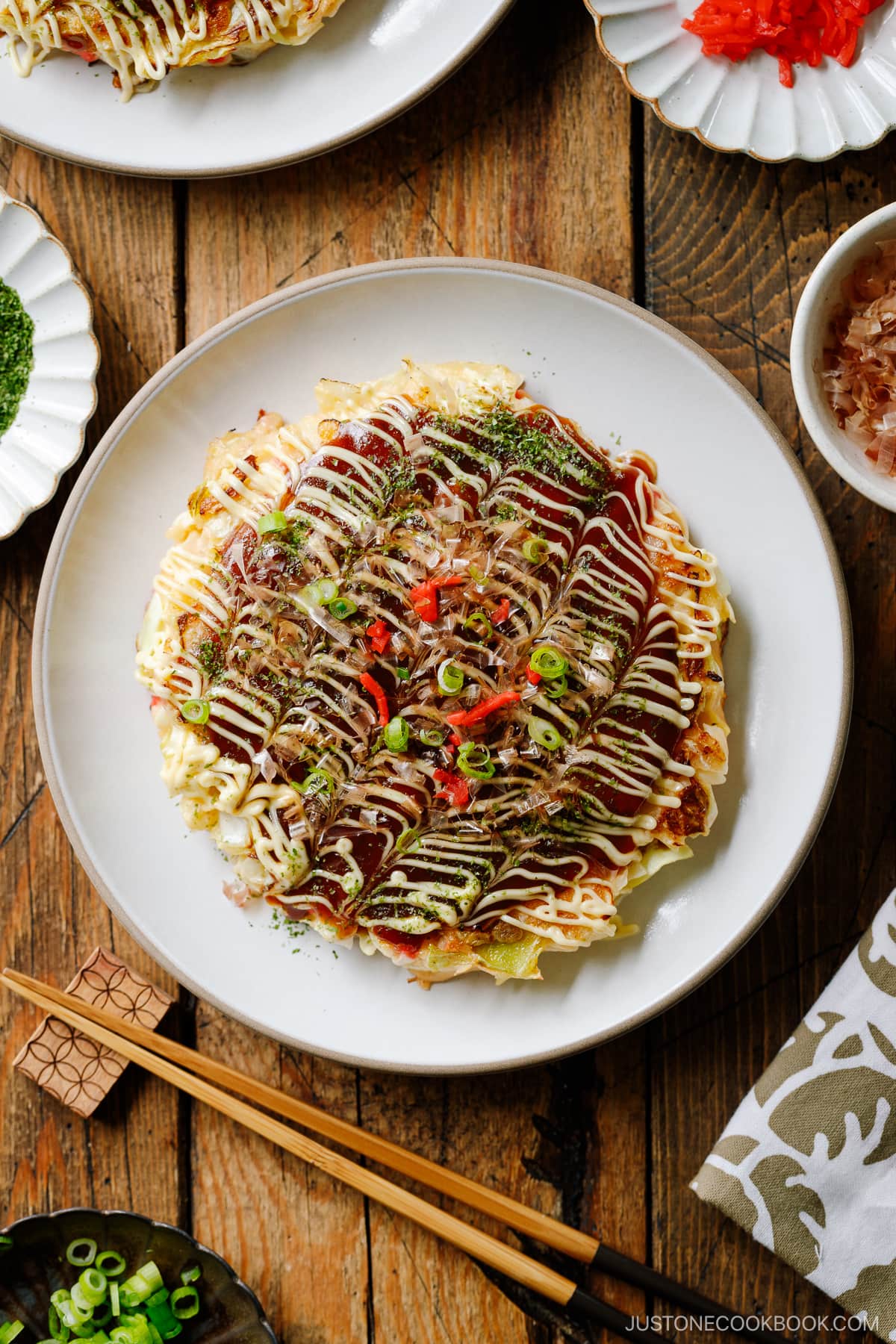
Among all the Osaka specialties, Takoyaki (たこ焼き) and Okonomiyaki (お好み焼き) are the most well-known. Today I’m sharing my favorite Okonomiyaki recipe with you so you can make this popular street food at home!
Table of Contents
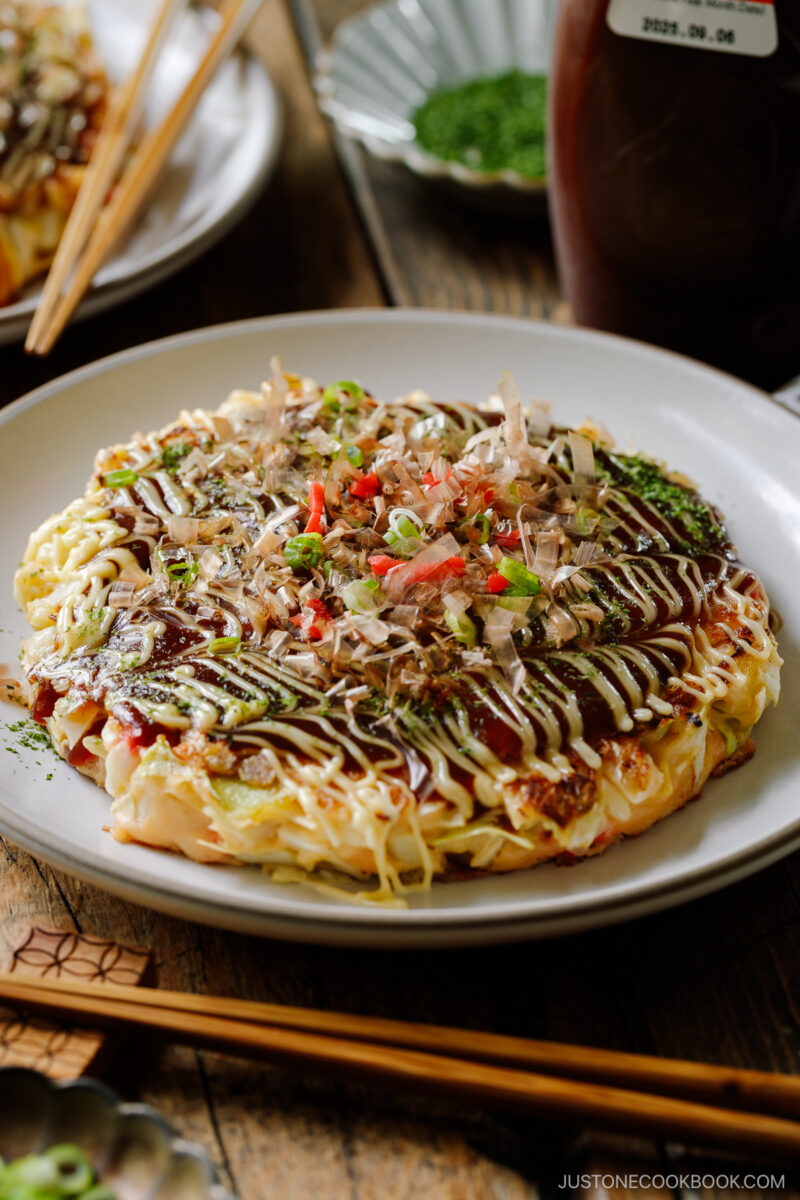
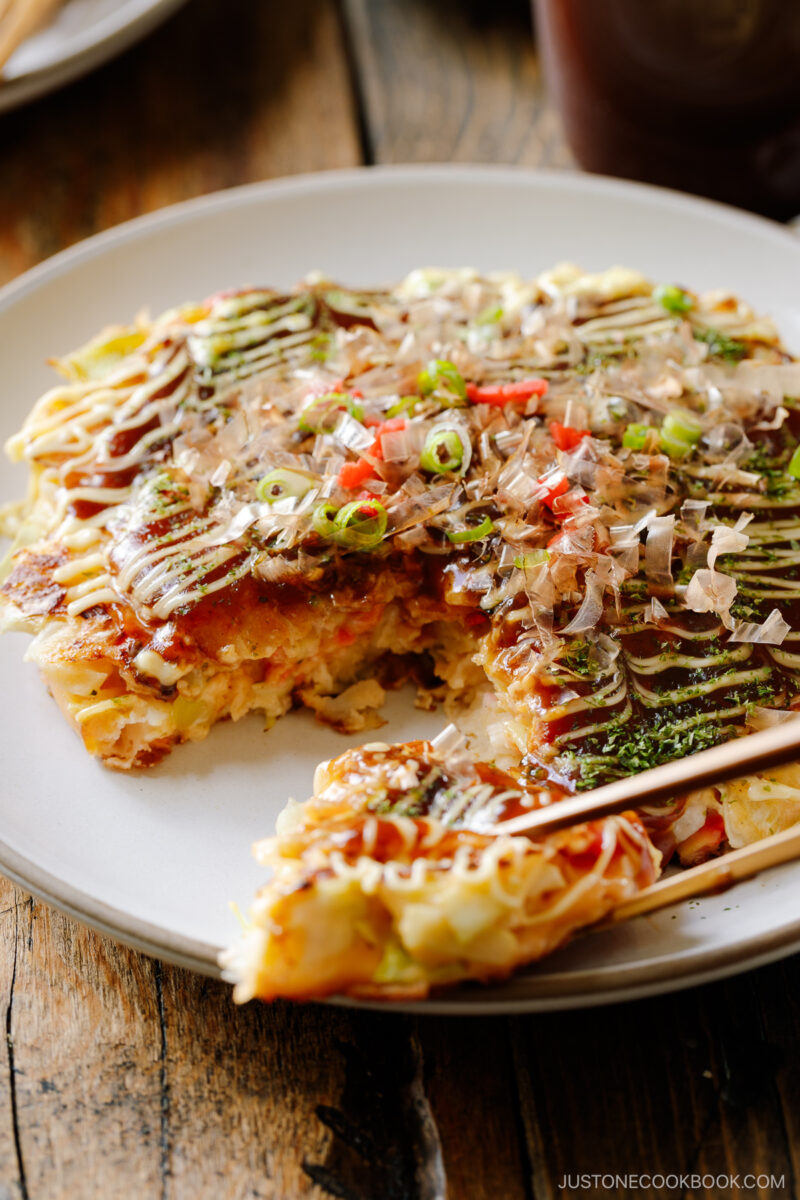
What is Okonomiyaki?
Okonomiyaki (お好み焼き) is a savory Japanese cabbage pancake. I’ve seen okonomiyaki referred to as a “Japanese pizza” or “Japanese frittata” in the U.S.
The batter is made with flour, tempura scraps (tenkasu), grated yam (nagaimo or yamaimo), and eggs. It’s then mixed with shredded cabbage and sometimes additional ingredients like shrimp and squid. A classic topping is pork belly slices, placed on top of the savory pancake while grilling. Once cooked, okonomiyaki is topped with a variety of condiments such as okonomiyaki sauce, Japanese Kewpie mayonnaise, dried seaweed, and dried bonito flakes.
This dish is highly adaptable even if you don’t eat pork or prefer another protein choice. The possibility for the filling and topping choices are endless, which is why this dish in Japanese translates to “grilled as you like it” – Okonomi (as you like it) Yaki (grill).
Why This Recipe Works
I’ve been making this recipe for my family and friends for over a decade, and everyone loves it.
- Easy and quick to make – Mix all the ingredients and cook!
- Budget-friendly – It’s a satisfying dish with economical ingredients.
- Family and kid-friendly – Okonomiyaki is customizable, and it’s fun to cook with family and friends at the table.
- Freezes and reheats well – I make ahead for future busy evenings. It’s a great meal prep dish!
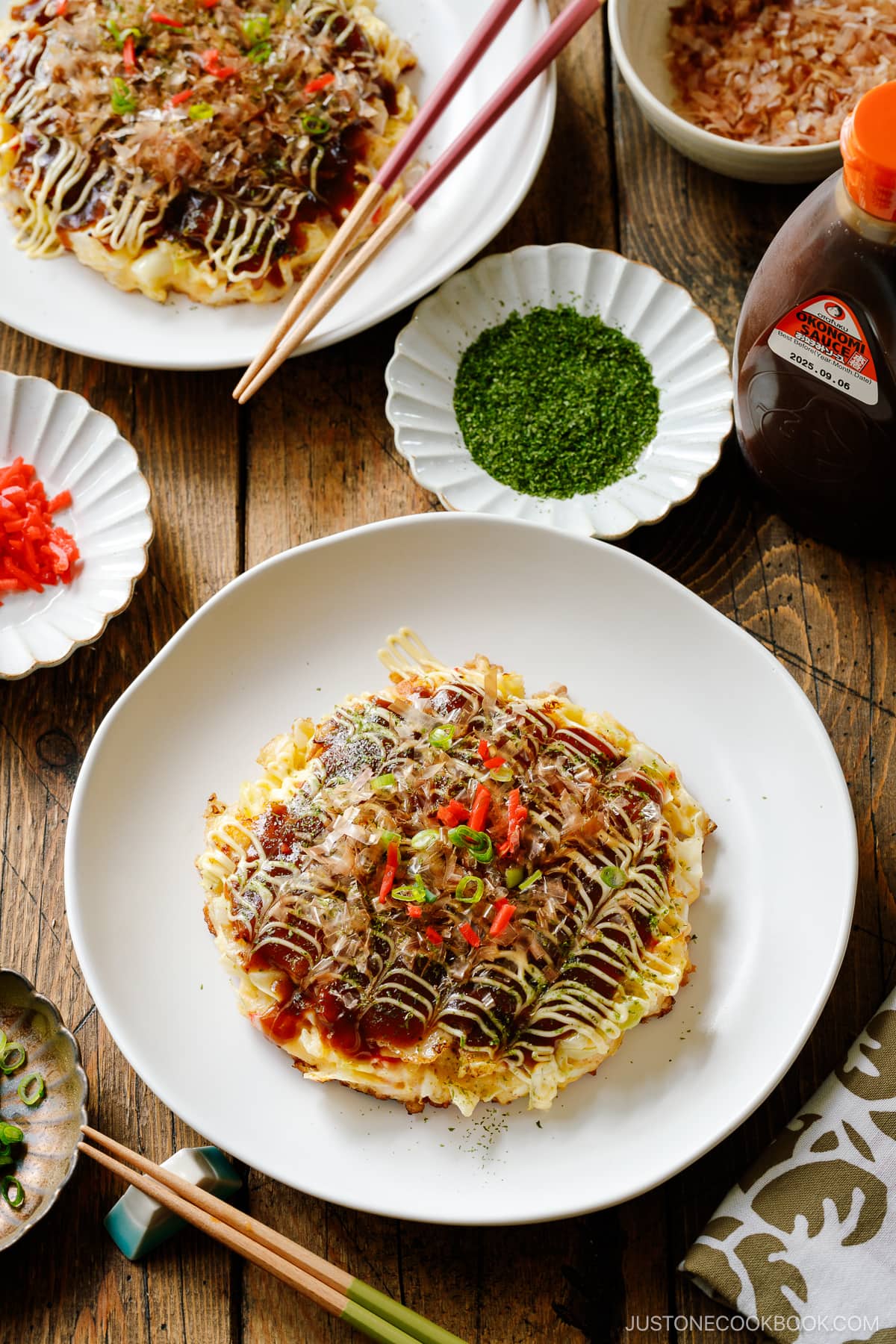
Ingredients for Okonomiyaki
To make really good authentic okonomiyaki, certain ingredients are necessary. Okonomiyaki tastes much better compared to versions that omit them. Read below for vegan/vegetarian options.
For the base batter
- All-purpose flour (plain flour)
- Salt
- Sugar
- Baking powder – Use aluminum-free baking powder like this.
- Grated mountain yam (nagaimo/yamaimo) – Can’t find it? Check out the substitutions below.
- Dashi (Japanese soup stock) – Never made this before? Read more about this topic in the section below. Use Vegan Dashi for vegan/vegetarian.
For the Okonomiyaki
- Eggs – Use JUST Egg for vegan.
- Tenkasu (tempura scraps) – Read more about this in the section below.
- Pickled red ginger (kizami shoga)
- Green cabbage
- Sliced pork belly (skip for vegan/vegetarian) – This is the most popular and classic topping, but check out other options I listed in the section below.
How to Make the Best Okonomiyaki
Check out the recipe card below for the full step-by-step tutorials, but here is a quick overview:
- Make the base batter. It’s said that making the base batter ahead of time improves the flavor and fluffiness of the okonomiyaki. It’s up to you. You can at least rest the batter a little while you prep other ingredients.
- Prep the ingredients. Cut all the ingredients. Make sure to drain the cabbage well so the moisture won’t dilute the batter. The salad spinner comes in handy!
- Make the okonomiyaki batter. Add eggs, tempura scraps, chopped red pickled ginger, then finely chopped cabbage. Mix them all together.
- Cook the okonomiyaki batter in frying pans or an electric griddle. I said pans (plural) so that you can cook two savory pancakes at a time.
- Add condiments and toppings. Enjoy!
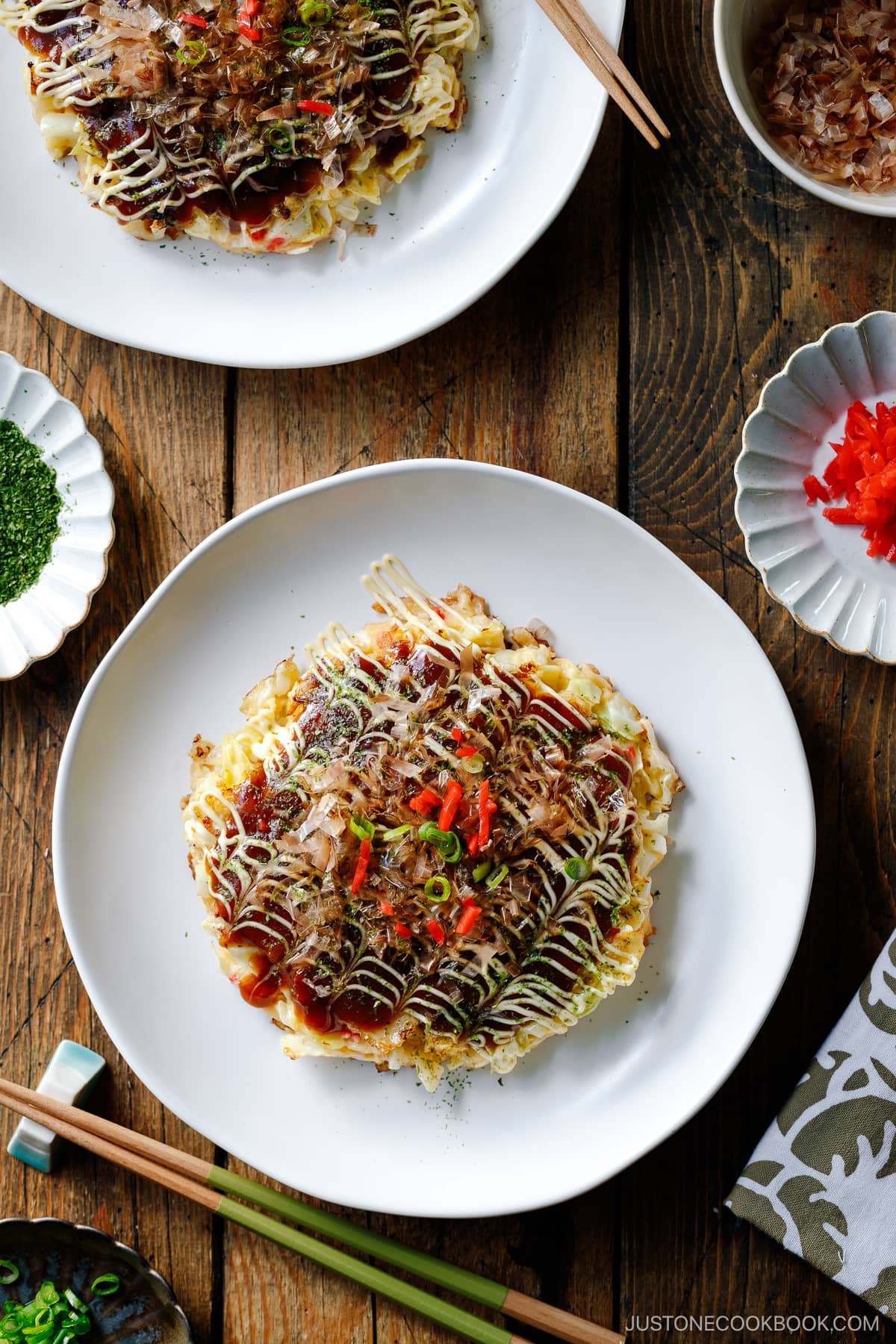
3 Key Ingredients and Their Substitutes
Let’s deep dive into the most important ingredients for okonomiyaki.
1. Nagaimo (Yamaimo)
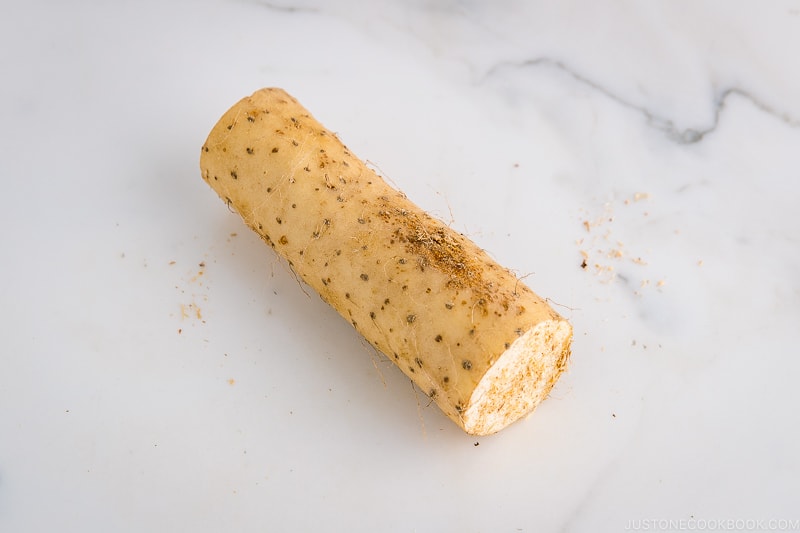
This is Japanese long yam (nagaimo) and it’s the most important ingredient to yield a non-doughy, fluffy okonomiyaki. Grated nagaimo yields a slimy, slippery, thick liquid, akin to lightly beaten egg whites. When cooked, it adds volume to the batter and creates a fluffy okonomiyaki.
Alternatively, you can use Japanese mountain yam (yamaimo) instead of nagaimo, but yamaimo is a thick and paste-like texture while nagaimo is a loose and liquid texture.
Some people may get an allergic reaction (like itching), so you can wear a kitchen glove to grate or wash your hands quickly.
You can purchase nagaimo/yamaimo at Japanese and most Asian grocery stores.
Nagaimo Substitute
After I tested a few substitute options I found on the internet, I think the combination of baking powder and beaten egg whites works the best.
- Baking powder — It’s a good substitute. Since we already add baking powder to this recipe, you’re just increasing it a little. I would double the amount in the recipe.
- Beaten egg whites — Another good substitute. Fluffy egg whites add volume to the savory pancake. Beat 2 egg whites for this recipe.
- Grated taro — I haven’t tried this, but it’s another “slimy and gooey” texture slightly similar to nagaimo. I will need to try this one day.
- Well-drained tofu — I don’t think it will work as well, but tofu gives a texture that is not dense. It might be an okay substitute, but be careful with moisture released by the tofu, as it dilutes the batter.
- Grated potatoes — NEVER use this as a substitute! The grainy texture of grated potatoes does not have any effect on the okonomiyaki except for adding cooked potato texture. We’re not making potato pancakes!
- Grated lotus root — I haven’t tried this, but I assume it has a similar texture as grated potato, so I don’t think it would add fluffiness to okonomiyaki.
2. Tenkasu (Tempura Bits/Scraps)
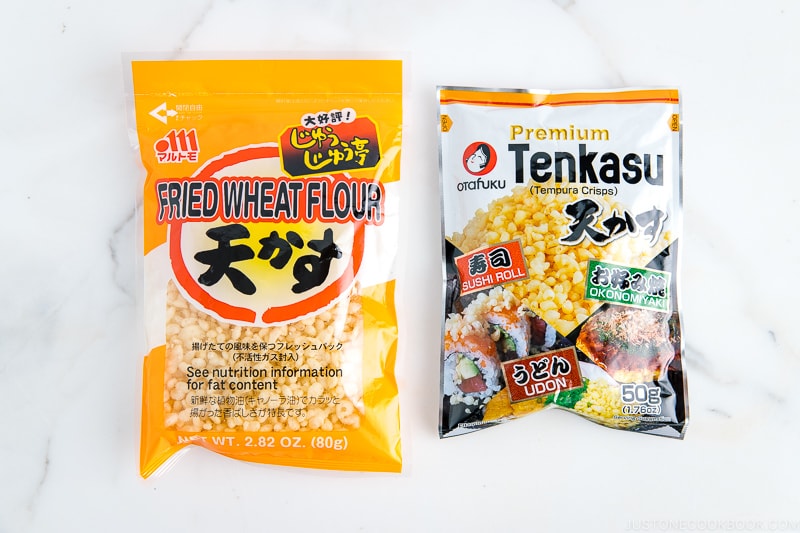
This is another ingredient to make the batter fluffier. When you see ‘tempura scraps,’ you might wonder if you can avoid it. Well, I understand it is not a healthy ingredient; however, many people in Osaka claim this is one of the most important ingredients, next to nagaimo/yamaimo. Fried food adds rich flavor, depth, and complexity to the dish.
You can buy a bag of tenkasu from Amazon or Japanese grocery stores.
Tenkasu Substitute
You can make your tempura scraps using the leftover batter. All you need is to drop the batter into hot oil and scoop it up when golden brown.
Some people online suggest substituting tenkasu with Asian shrimp chimps (Kappa Ebisen, かっぱえびせん). I haven’t tried that, but it sort of has a similar texture and flavor.
3. Dashi (Japanese soup stock)
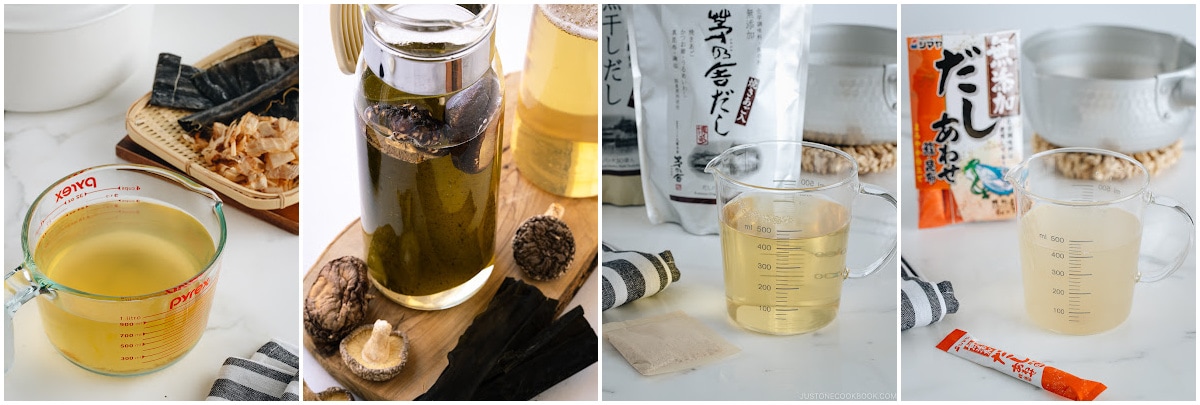
Dashi, or Japanese soup stock, is the key ingredient for most Japanese foods. It’s what makes Japanese food authentic. Without dashi, it’s not a true okonomiyaki!
The best part is that it’s super quick and easy to make! Please do not substitute dashi with water, vegetable stock, or chicken stock.
There are three ways to make dashi.
- Homemade dashi — You can make a basic Awase Dashi from scratch by steeping kombu (edible kelp) and katsuobushi (dried bonito flakes) in water. If you’re vegetarian/vegan, use Kombu Dashi or make Vegan Dashi with kombu and dried shiitake mushrooms.
- Dashi packet — The dashi packet is the best shortcut method that I use often. Similar to making tea, you steep the dashi packet in water and cook for a couple of minutes. Despite its quick method, the flavor of dashi is good.
- Dashi powder — Dashi powder (dashi granules) is my least favorite method due to its lack of flavor. The flavor and fragrance do not last long. But you can make a quick dashi with just dashi powder and hot water.
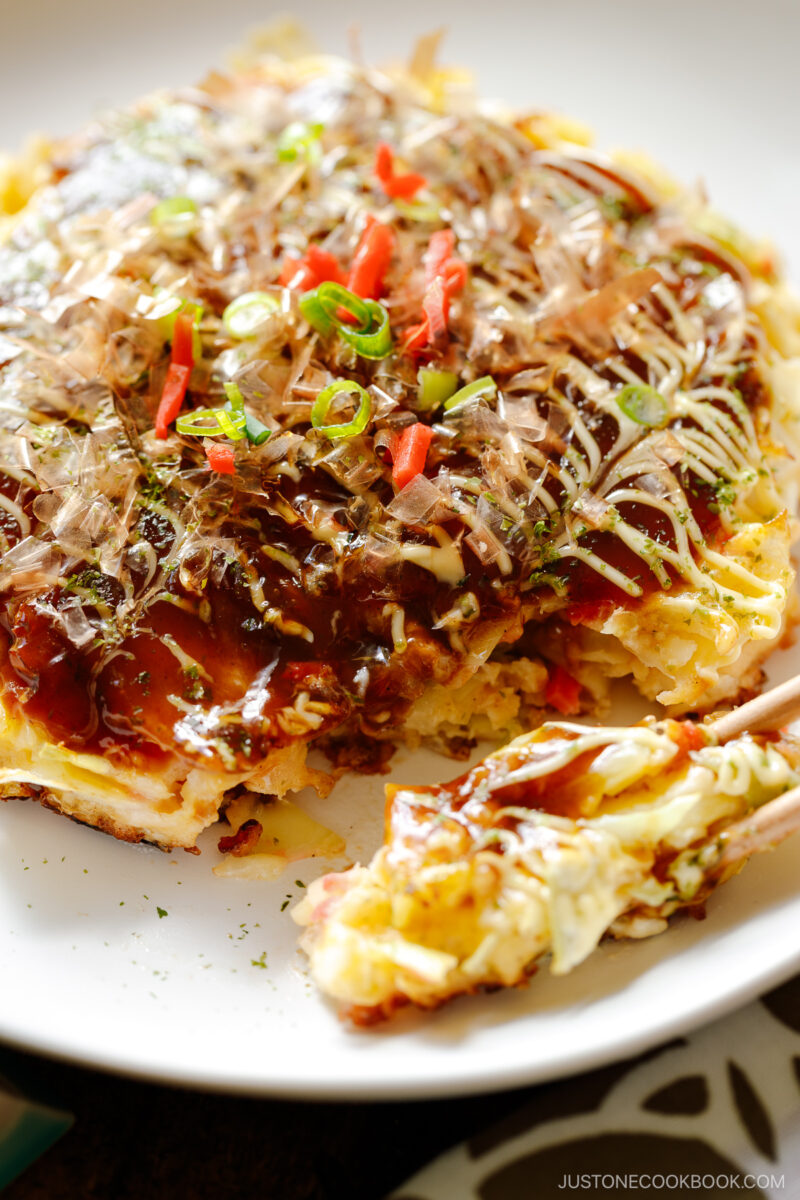
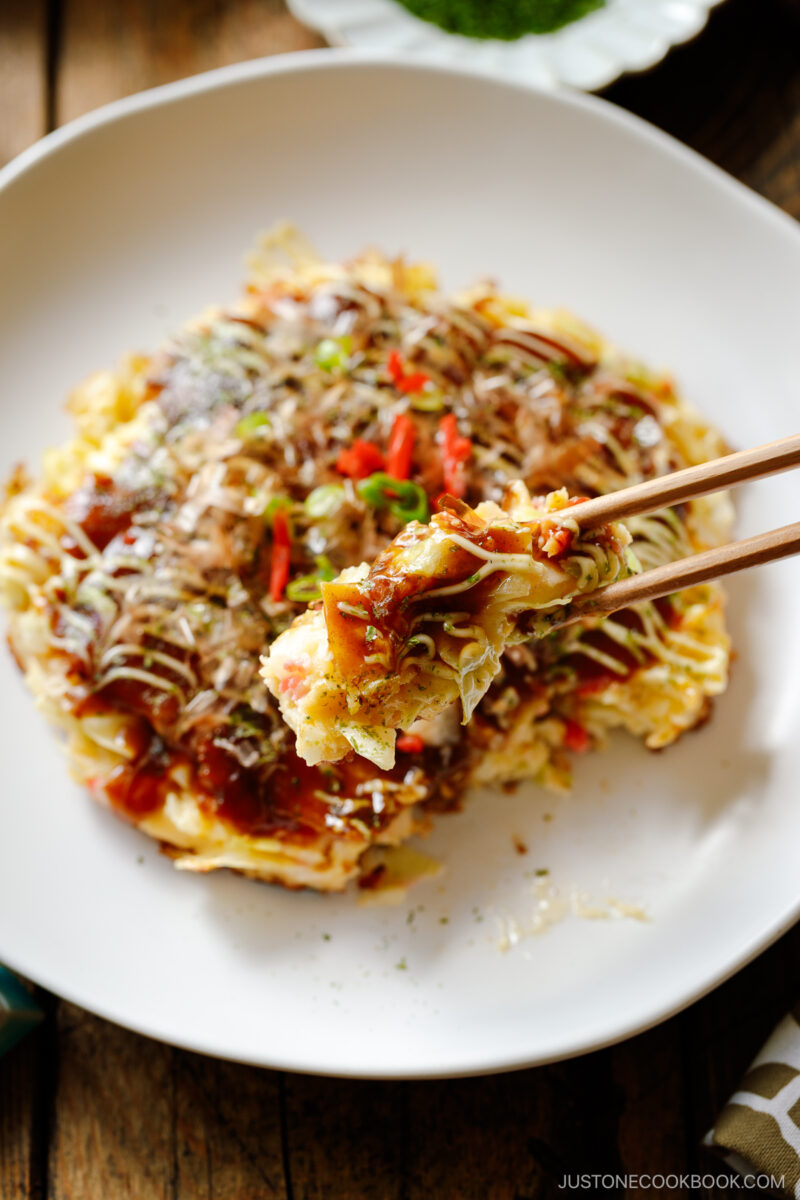
Condiments and Toppings
Thanks to online shops like Amazon, we can get all these Japanese condiments and toppings easily these days. Make your okonomiyaki authentic with the following items!
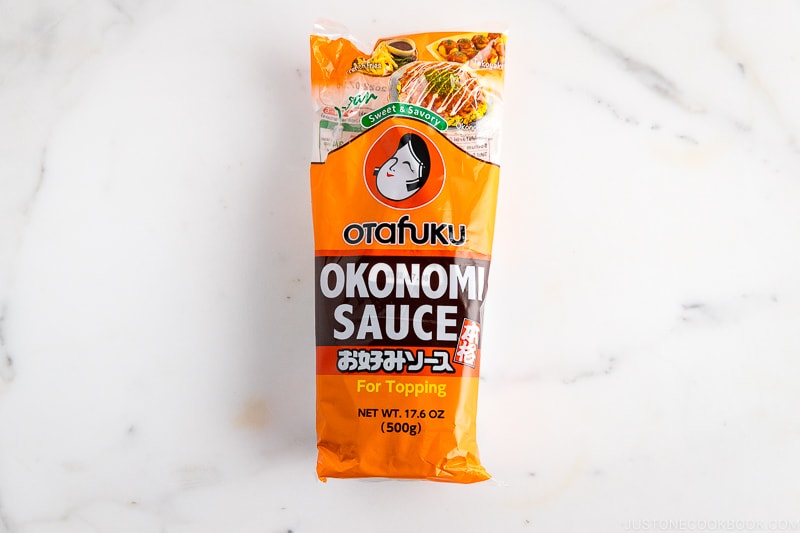
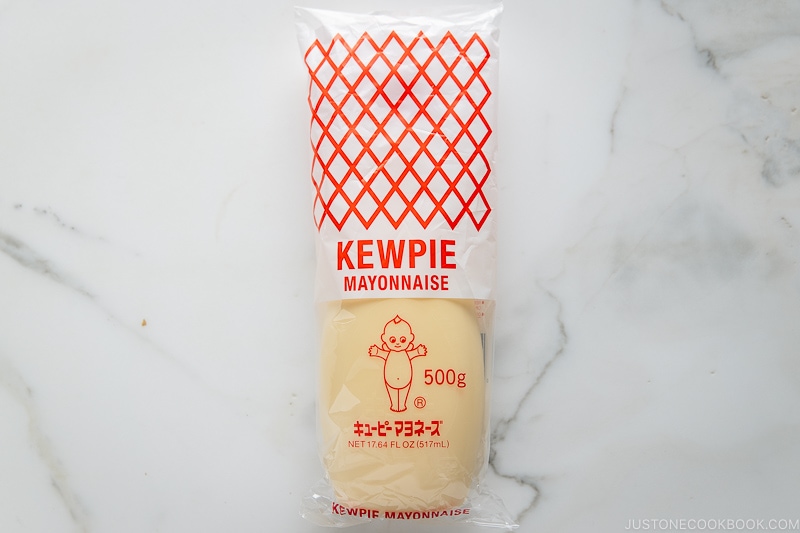
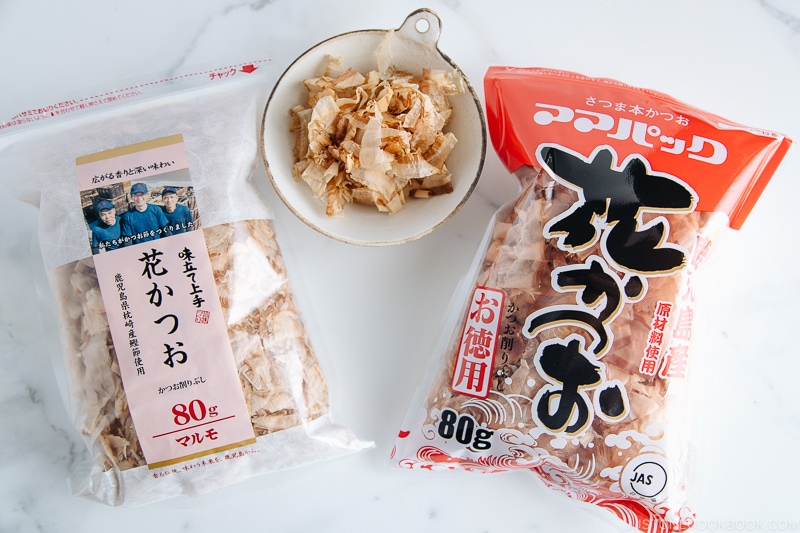
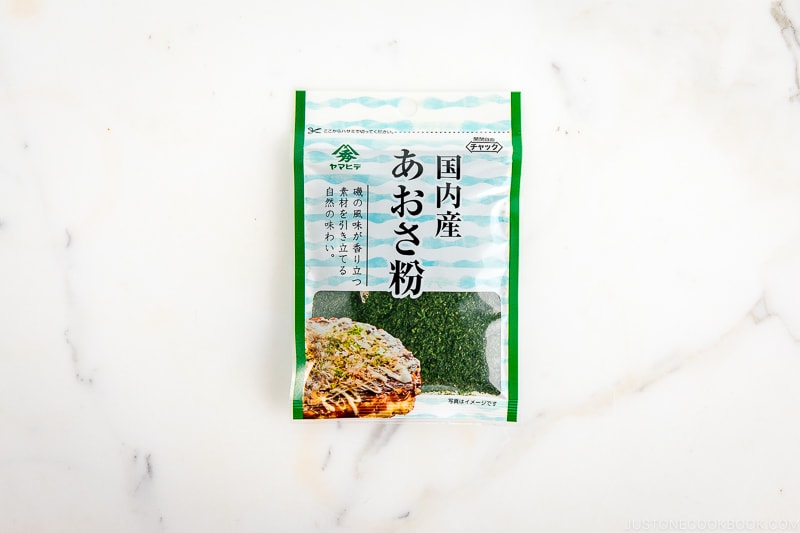
- Okonomiyaki sauce – The taste of the okonomiyaki strongly relies on the okonomiyaki sauce. I love the Otafuku brand’s Okonomi Sauce, which you can get from Amazon or Japanese/Asian grocery stores. For those who can’t get this sauce, I made a homemade version using just four ingredients. This homemade version tastes good, similar to Otafuku sauce!
- Japanese Kewpie mayonnaise – Osaka’s specialty, both Takoyaki and Okonomiyaki, has squirts of mayonnaise along with the sweet-savory takoyaki/okonomi sauce. But this is optional even for locals. I love the combination of flavors from both sweet savory okonomi sauce and creamy and tangy mayo. You can purchase a Kewpie brand from Amazon and Japanese/Asian grocery stores or you can make Homemade Japanese Mayonnaise.
- Katsuobushi (Dried Bonito Flakes) – Katsuobushi is shaved flakes of fermented and smoked bonito and these flakes are super paper-thin! It’s a super umami-rich ingredient that’s used for making dashi (Japanese soup stock). When you sprinkle them on top of the okonomiyaki, they dance along with the steam! You can buy it from Amazon and Japanese/Asian grocery stores. You can omit this ingredient if you dislike the fishy smell.
- Aonori (Dried Green Seaweed) – It is dried green (ao) seaweed (nori) flakes/powder. This umami-rich seaweed has a bright, intense green color and a unique fragrance. You can buy aonori from Amazon and Japanese/Asian grocery stores. Or you can substitute with regular nori if you can’t find it. Interesting fact: In ancient Japan, ao (pronounced as [ah-o]) means green in the traditional Japanese language. There were 4 colors; white, black, red, and green. These days, ao means blue in contemporary Japanese.
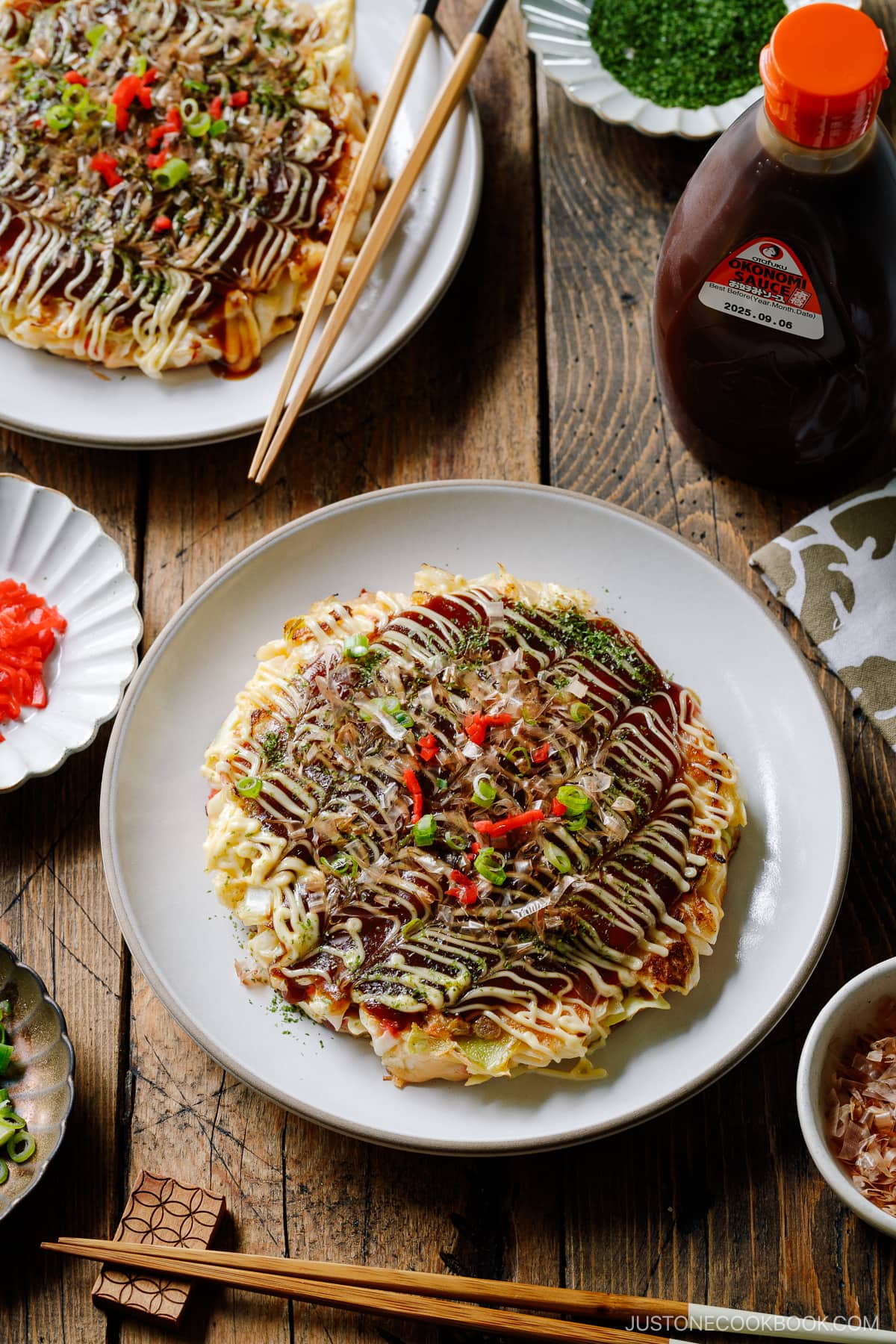
Optional Add-On Ingredients for Okonomiyaki
Besides the key ingredients above, there are other ingredients that you can add to the batter.
- Seafood – calamari/squid (my favorite), shrimp, scallops, octopus, or dried small shrimp (sakura ebi)
- Yakisoba noodles – Noodle-included okonomiyaki is called Modern Yaki (モダン焼き).
- Rice cakes (kiri mochi) – This is my favorite! You can get it on Amazon. Cut the mochi into small cubes and place them on the pan before pouring the batter over them.
- Shredded cheese
- Shiso leaves (Ooba) – My favorite!
- Mentaiko or tarako (spicy or non-spicy cod/pollack roe)
- Fish cakes (chikuwa)
- Vegetables – Parboiled potatoes, bean sprouts, sweet corn, garlic chives,
- Kimchi
- Mushrooms – I haven’t tried, but it’s a great vegetarian topping option.
Can We Use Okonomiyaki Flour (Mix)?
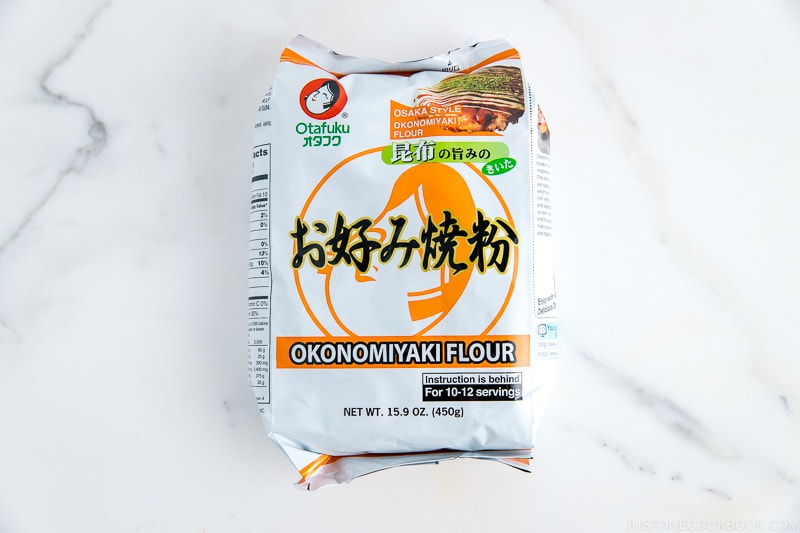
You can find a bag of Okonomiyaki Flour (Mix) at Japanese/Asian grocery stores. Just like pancake mix, all you need to do is add the egg(s) and water to the flour. After making the okonomiyaki batter, add shredded cabbage and other ingredients, if you like. It’s easy and quick, but I still like to recommend making your own okonomiyaki batter from scratch at home!
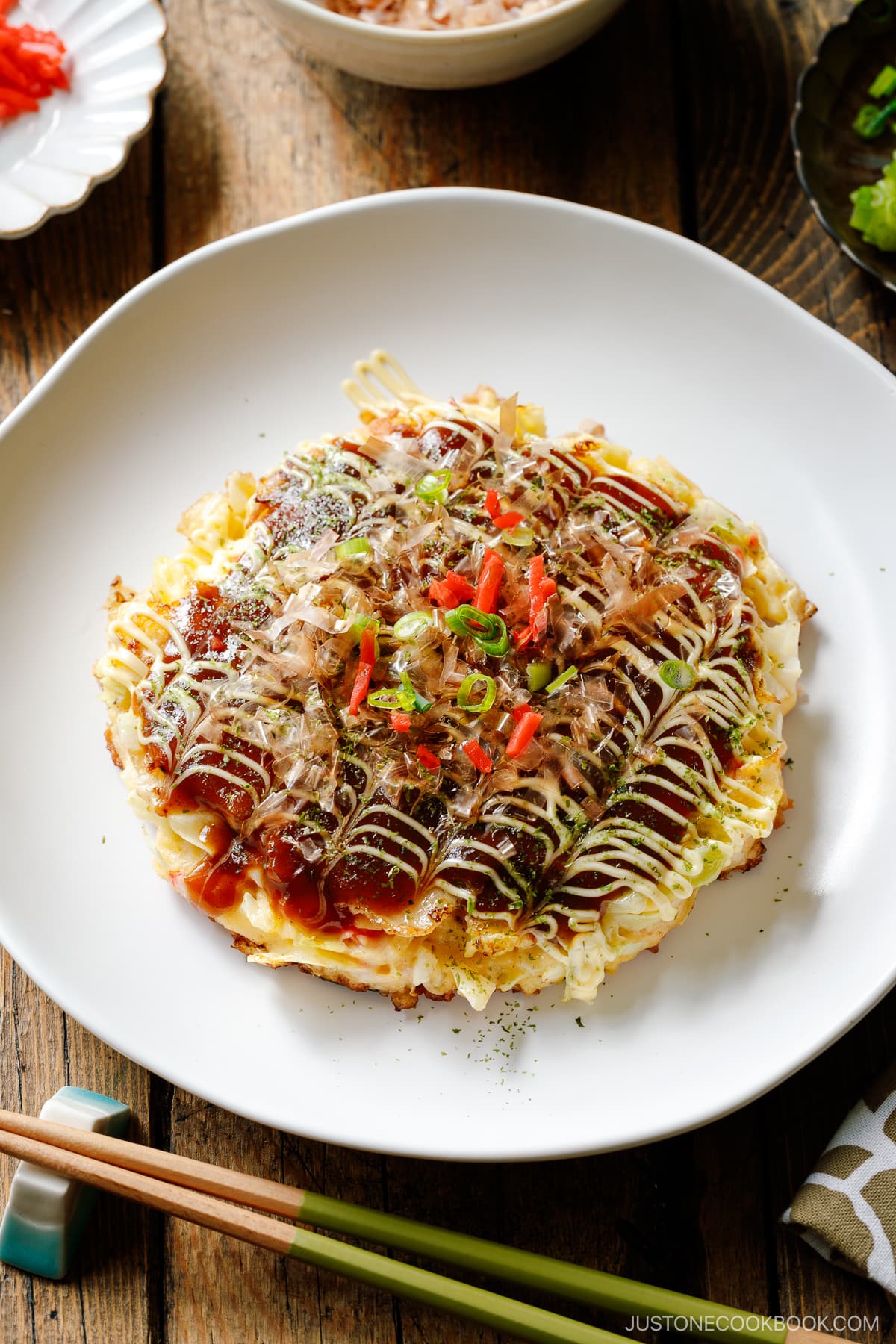
Okonomiyaki Restaurants in Japan
You can enjoy this dish at okonomiyaki restaurants (Okonomiyaki-ya お好み焼き屋) throughout Japan. There are usually 3 dining options:
- At a counter in front of a huge teppan (iron griddle), the chefs make them right in front of you.
- At a table that has built-in teppan (iron griddle), you can cook your own, but the staff will help you make it if you ask.
- The okonomiyaki is prepared and made in the kitchen, and they place it on a teppan (iron griddle) in front of you to keep it warm.
Besides restaurants, you can also purchase steaming hot okonomiyaki from street vendors during festivals (matsuri).
It’s not easy to replicate the food made on a hot iron griddle at home, and okonomiyaki made on the iron griddle simply tastes better. This is why sometimes I still choose to go to a restaurant even though I can make it easily at home.
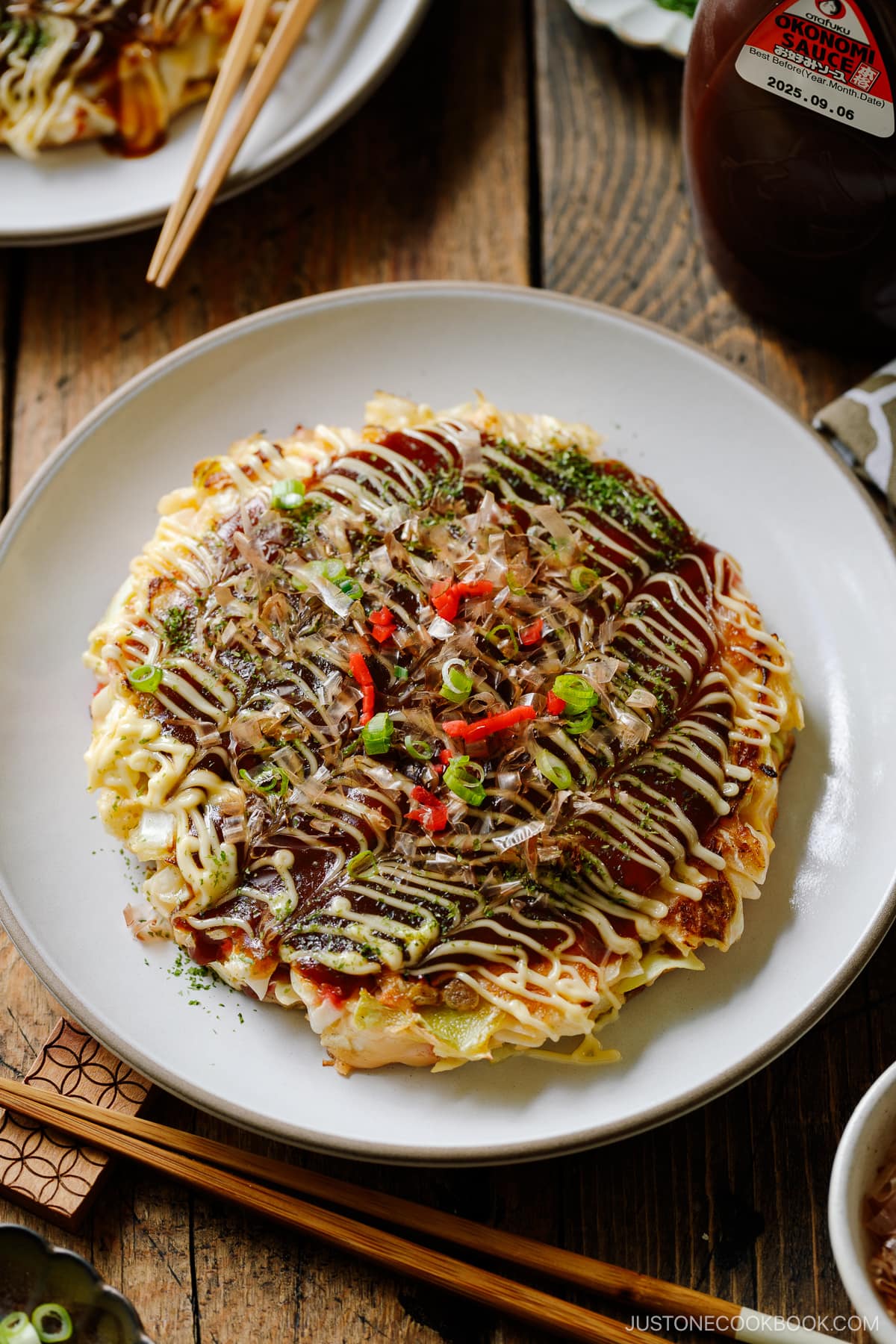
Hiroshima-style Okonomiyaki
Hiroshima-style okonomiyaki uses almost the same ingredients, but they are layered rather than mixed in with the batter like Osaka-style. Not only that, fried egg and yakisoba noodles (or sometimes udon noodles) are used as toppings.
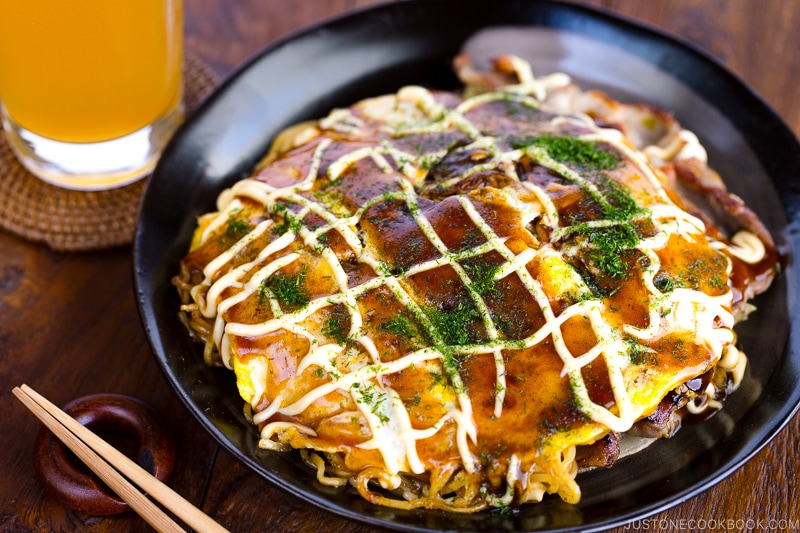
If you prefer the Hiroshima-style Okonomiyaki recipe, click here.
What to Serve with Okonomiyaki
Okonomiyaki is made with cabbage, eggs, and flour, so I recommend serving it with various vegetable and protein-packed side dishes.
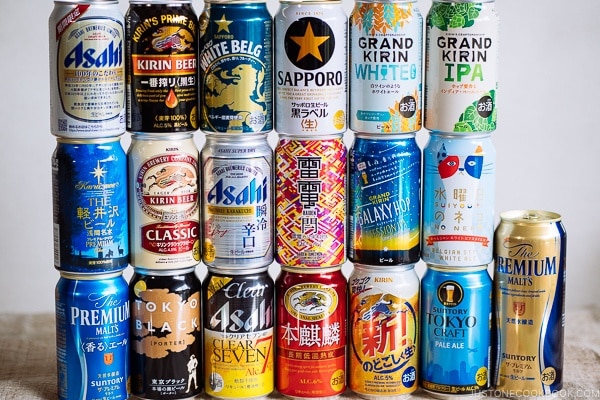
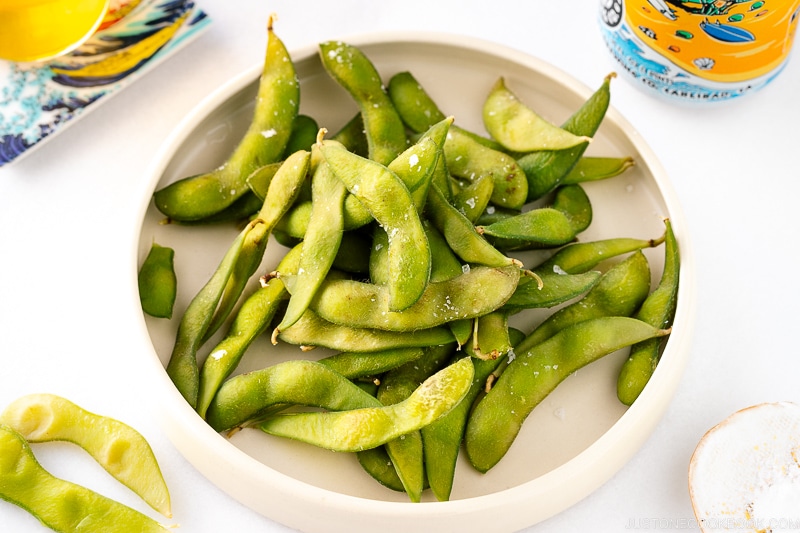
- Japanese beer
- Edamame or Spicy Edamame
- Harusame Salad
- Spinach Namul and Bean Sprout Namul
- Tomato Salad
- Hiyayakko (Cold Tofu)
- Teba Shio (Salted Chicken Wings)
- Japanese Fried Chicken (Karaage)
Readers’ Okonomiyaki Recipes
Okonomiyaki was the challenge recipe for the JOC Cooking Challenge March 2024. Check out the delicious dishes created by JOC readers!
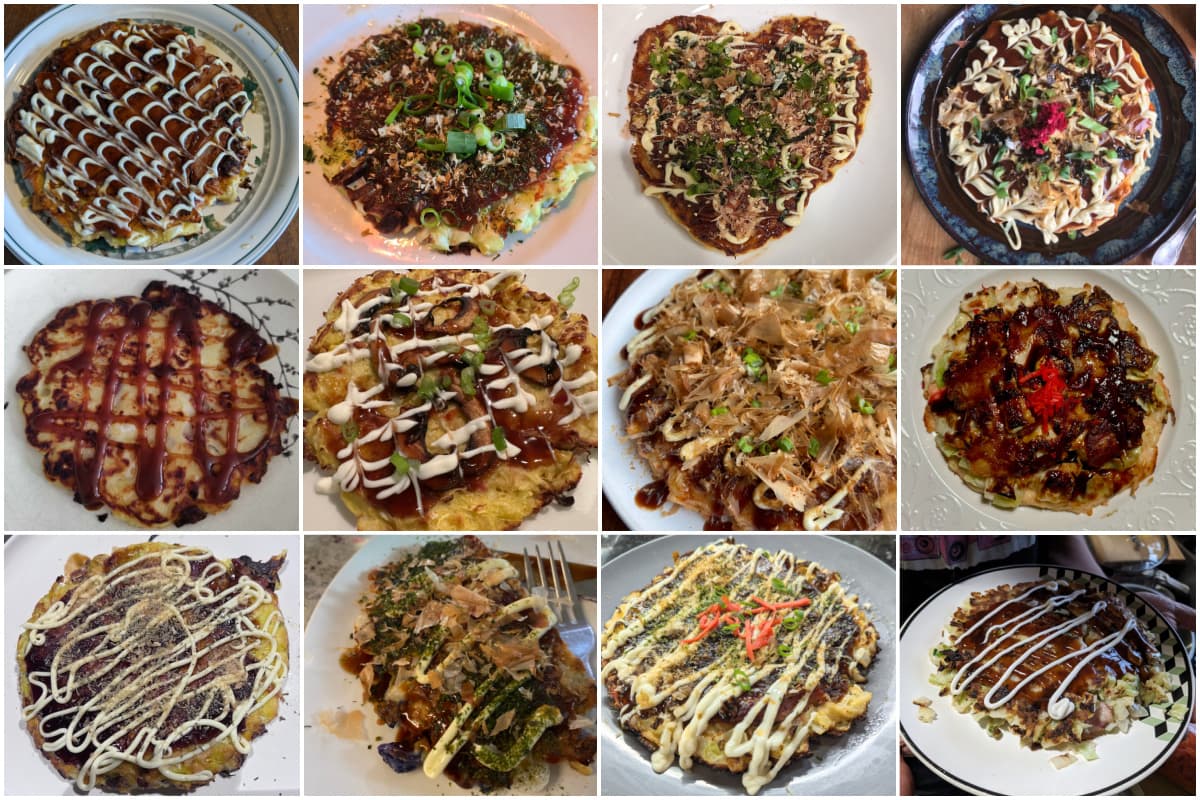
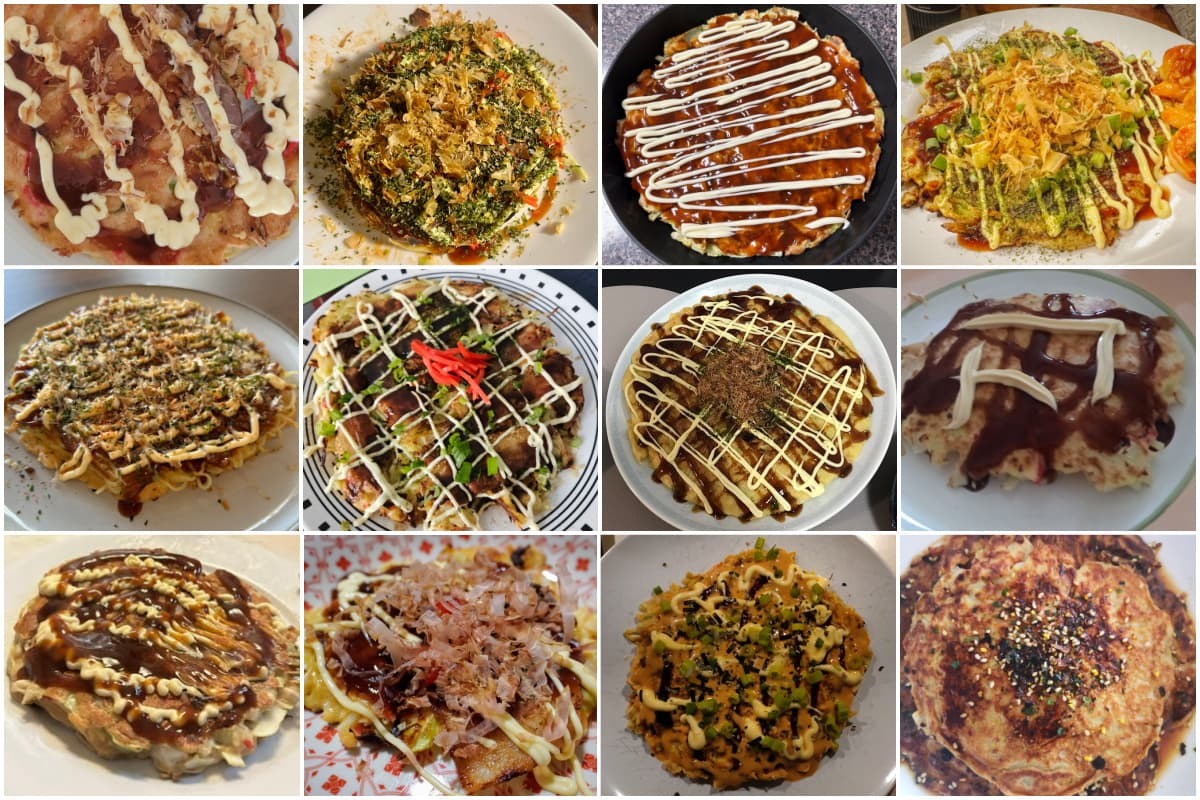
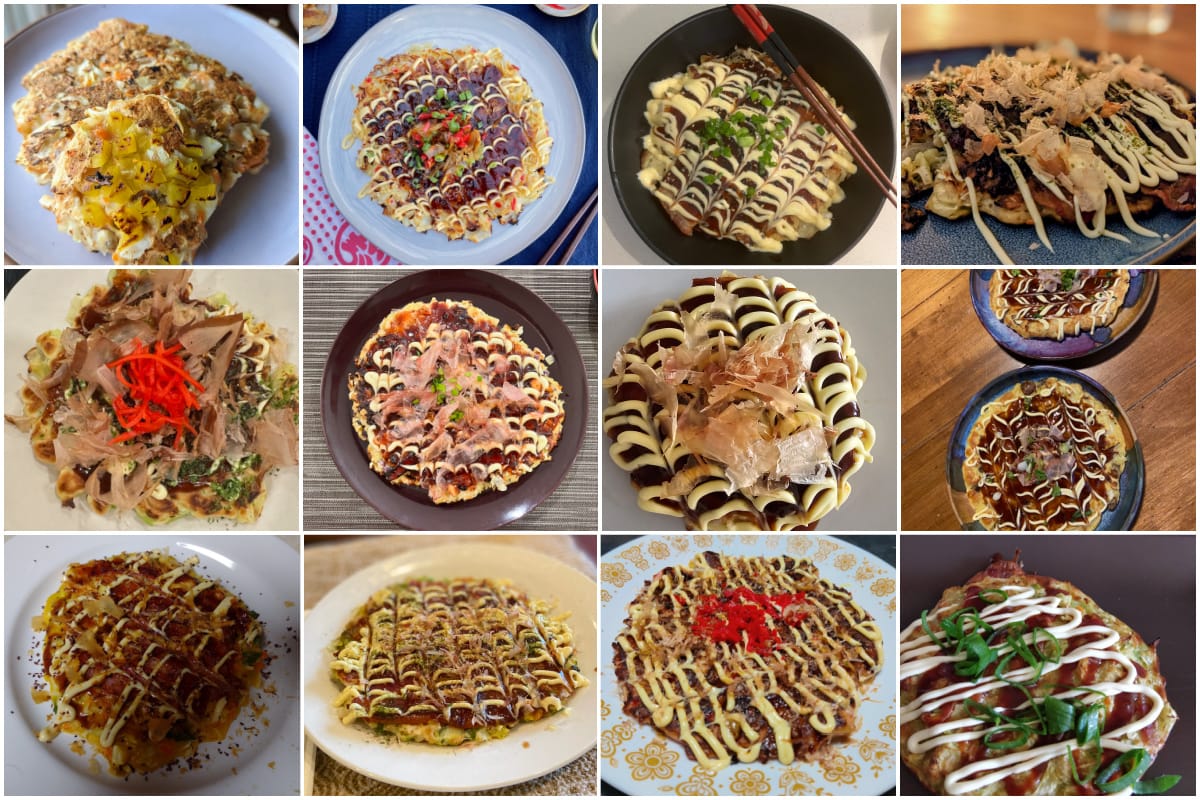
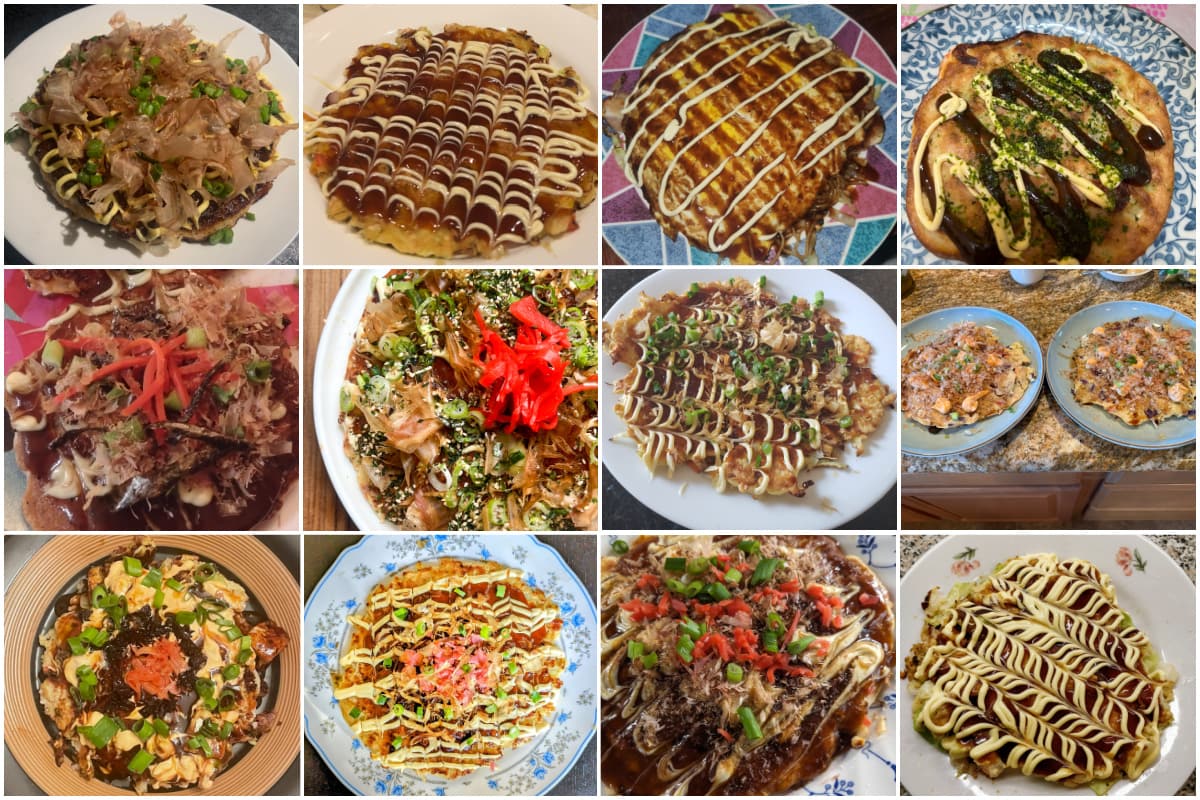
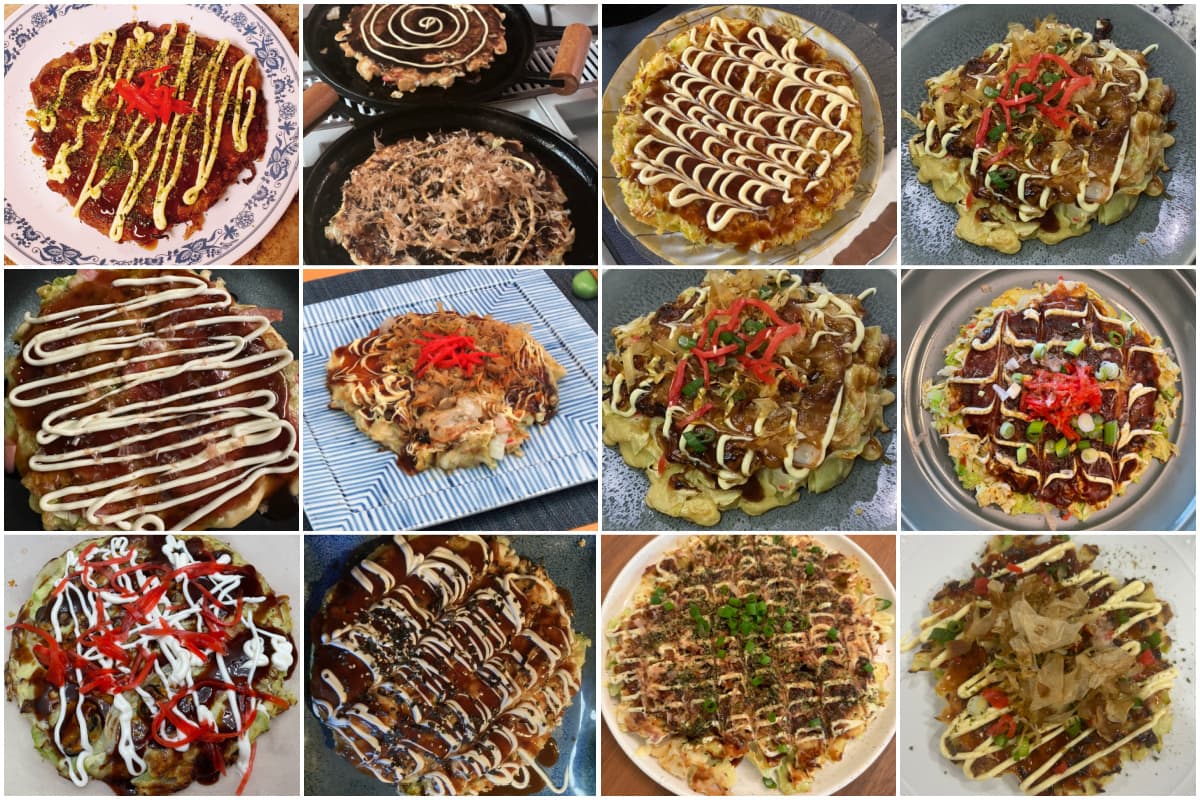
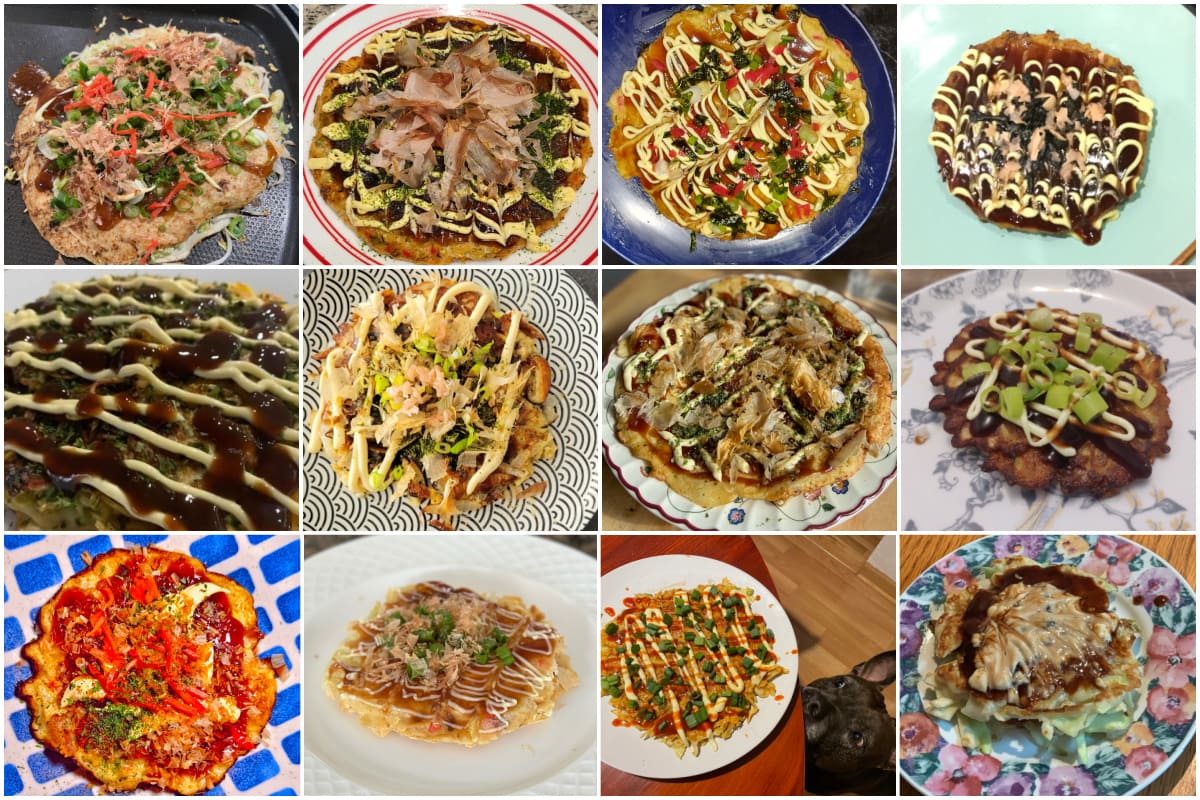
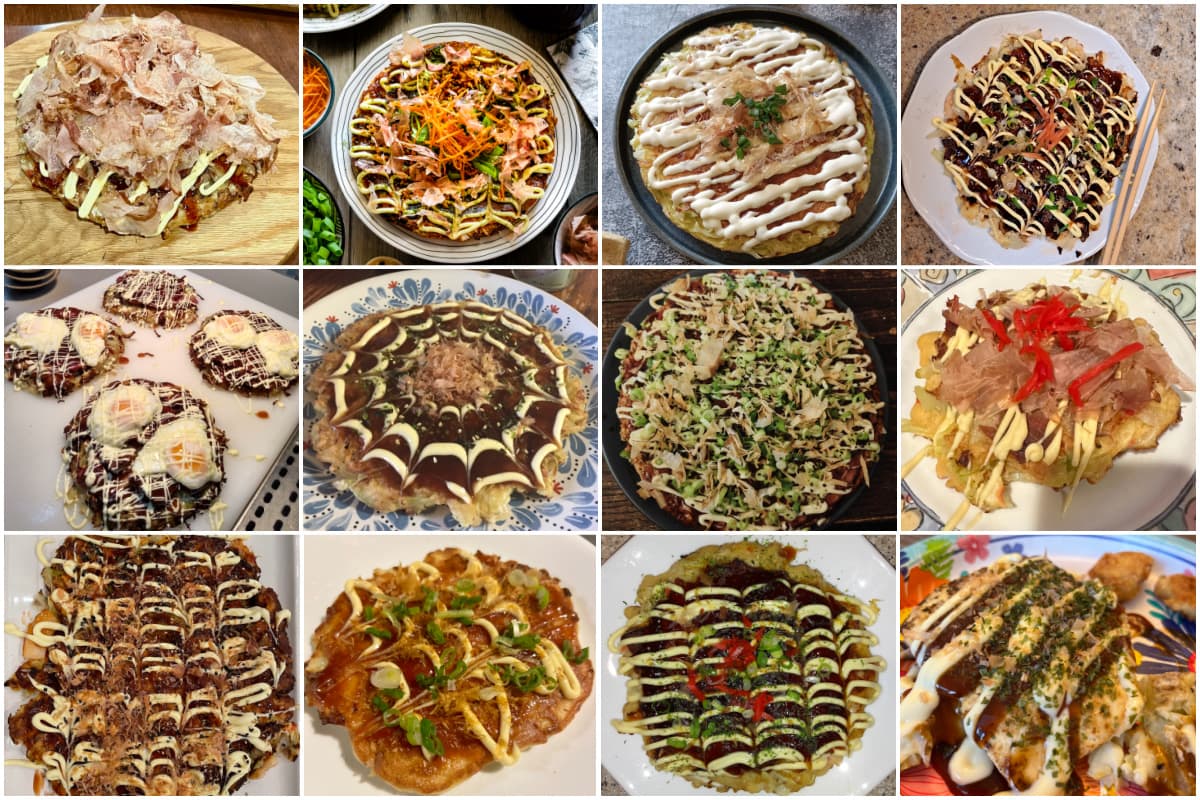
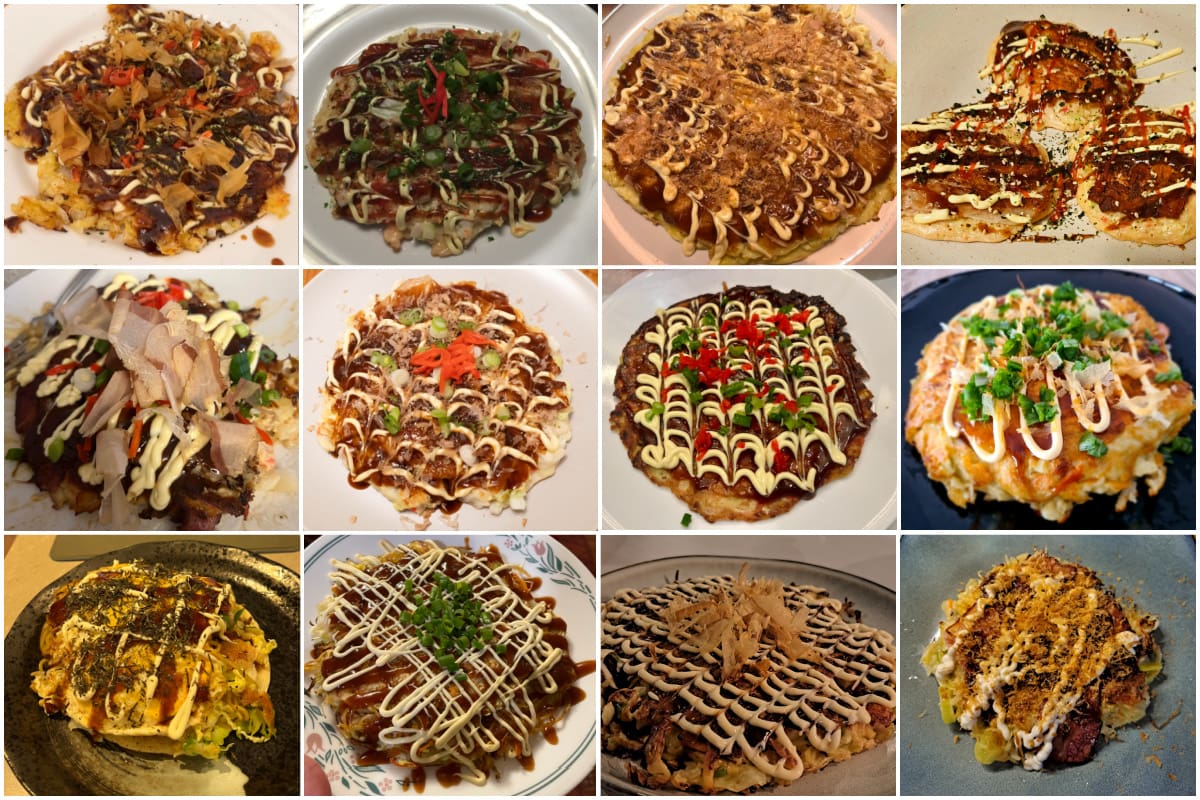
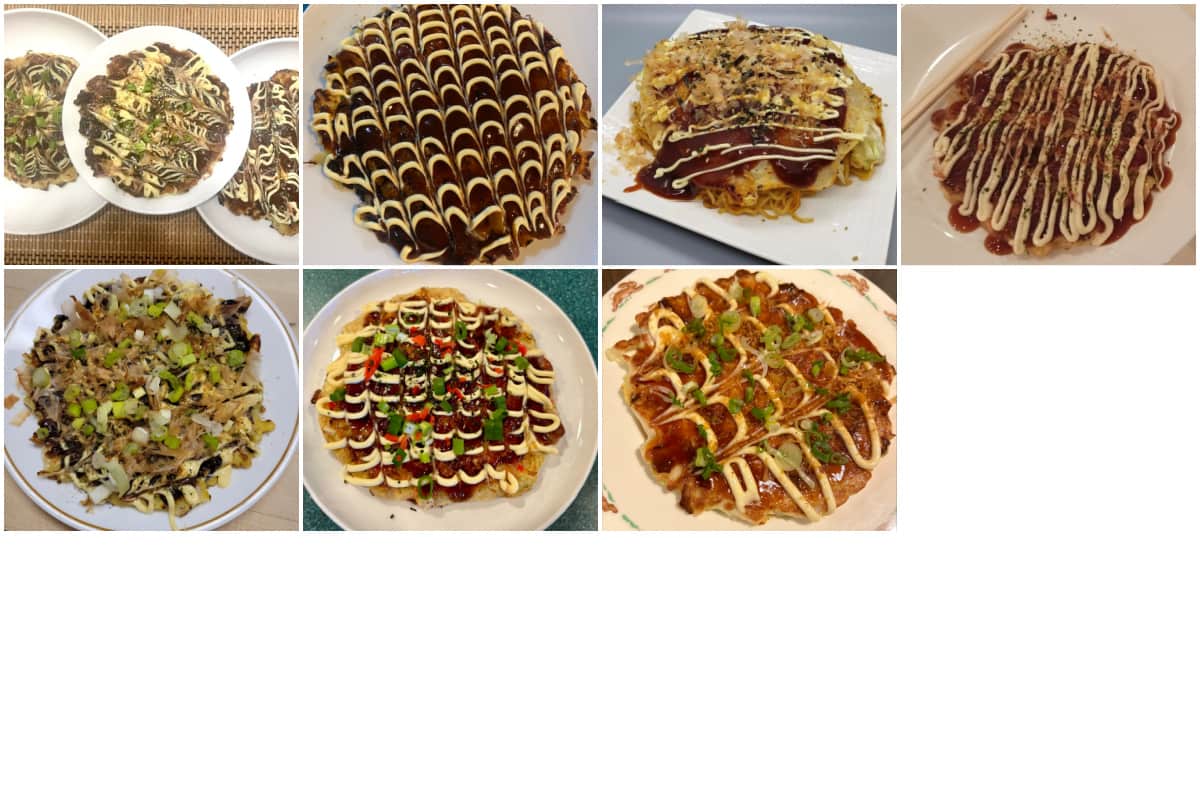
More Popular Japanese Street Food Recipes
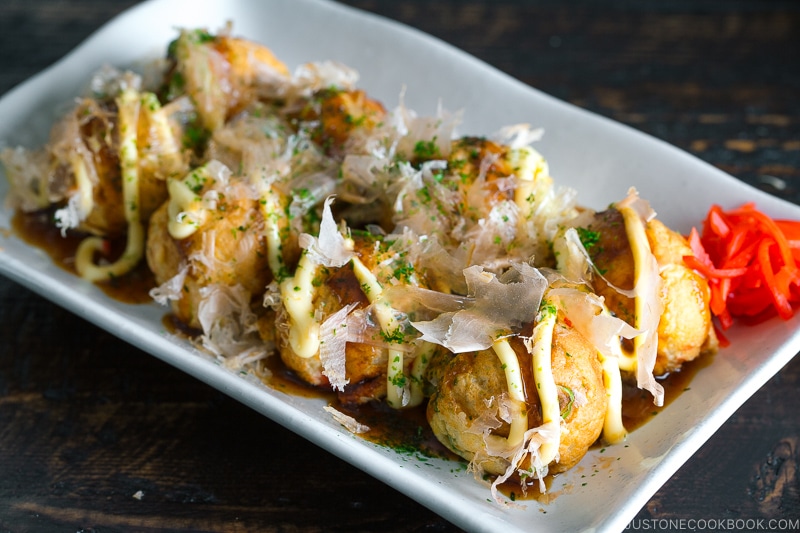
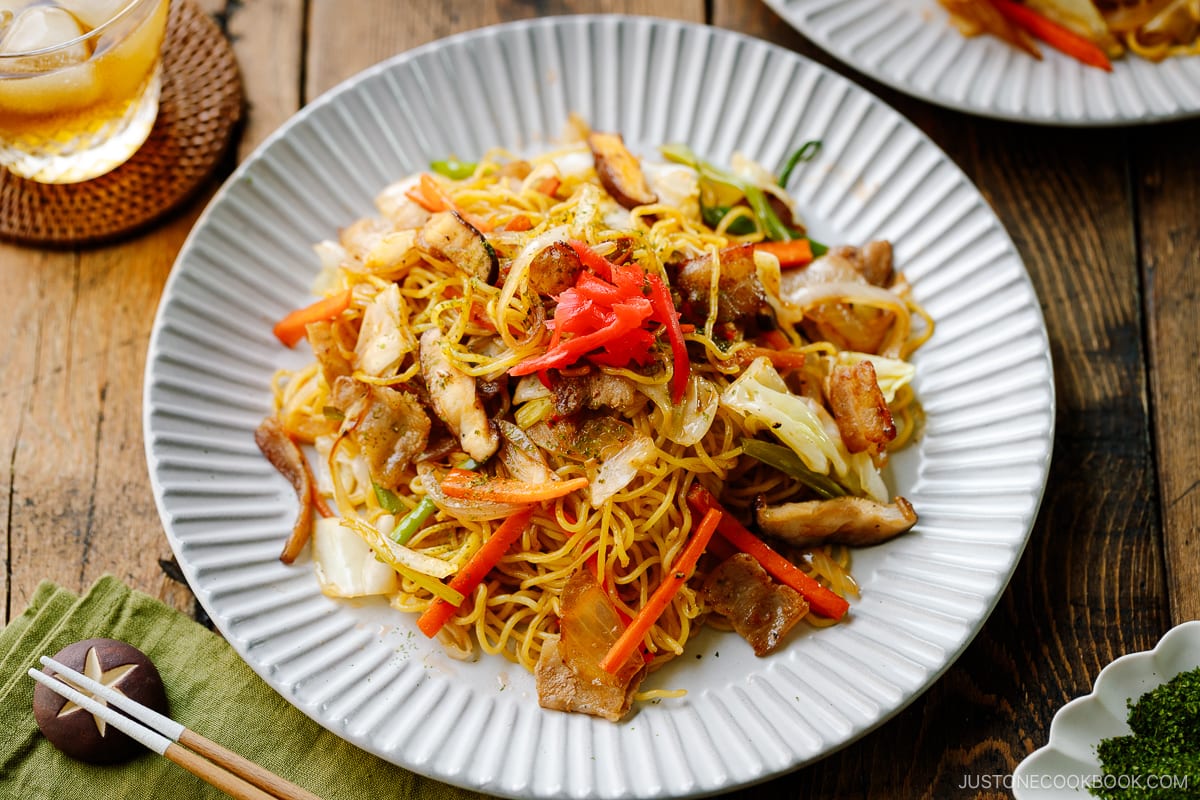
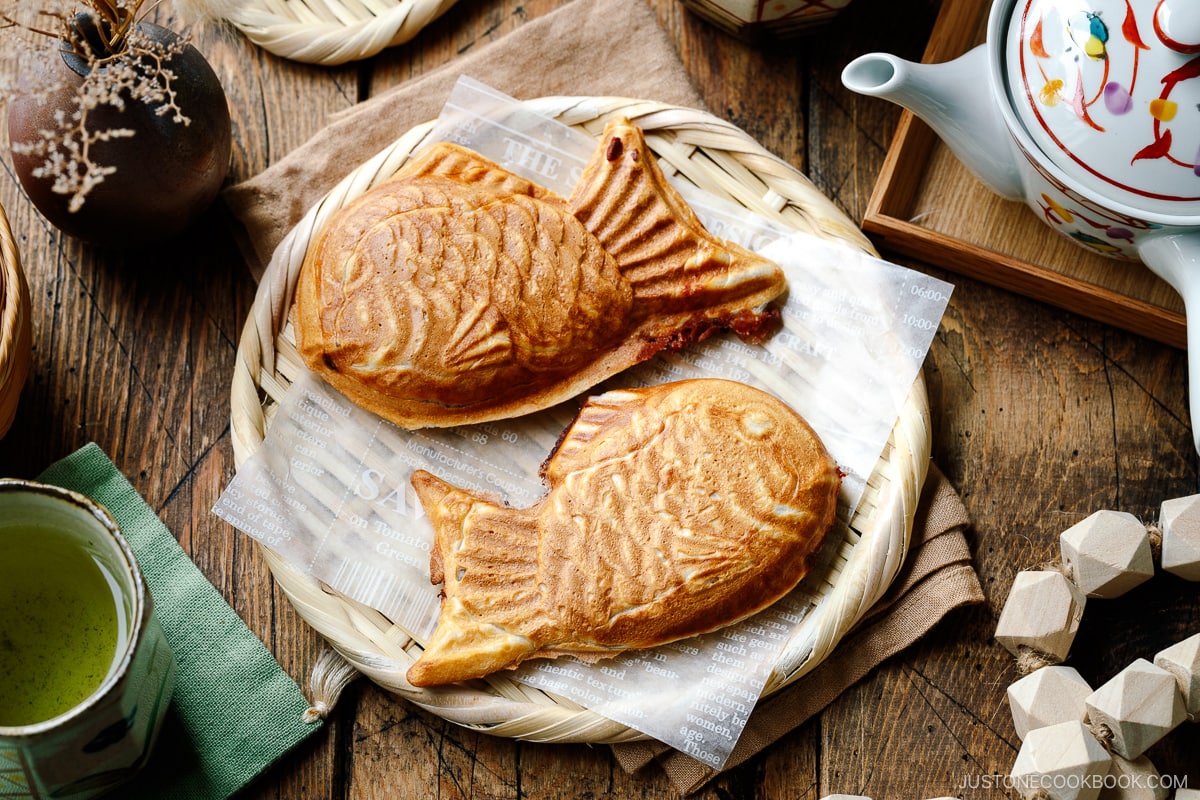
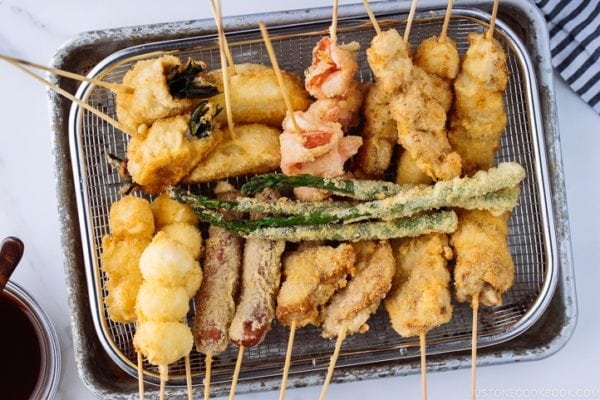
- Takoyaki (Octopus Balls)
- Yakisoba (Japanese Stir-Fried Noodles)
- Taiyaki (fish-shape cake with red bean filling)
- Kushikatsu (Kushiage)
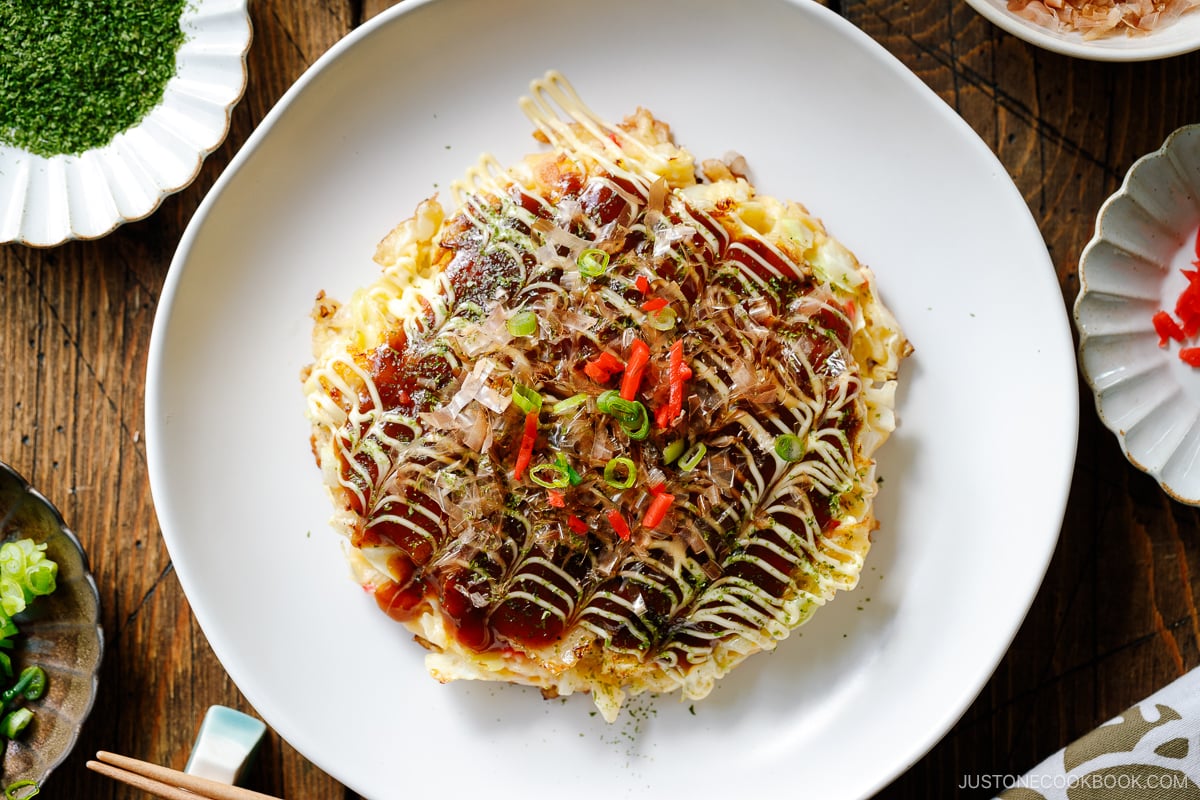
Wish to learn more about Japanese cooking? Sign up for our free newsletter to receive cooking tips & recipe updates! And stay in touch with me on Facebook, Pinterest, YouTube, and Instagram.
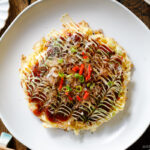
Okonomiyaki
Video
Ingredients
For the Base Batter
- 1 cup all-purpose flour (plain flour) (weigh your flour; for weights, click the Metric button; or use the “fluff and sprinkle“ method and level it off)
- ¼ tsp Diamond Crystal kosher salt
- ¼ tsp sugar
- ¼ tsp baking powder
- 5.6 oz nagaimo/yamaimo (mountain yam) (2–3 inches, 5–8 cm)
- ¾ cup dashi (Japanese soup stock) (use standard Awase Dashi, dashi packet or powder, or Vegan Dashi)
For the Okonomiyaki
- ½ head green cabbage (large; 1.4 lb, 640 g)
- ¼ cup pickled red ginger (beni shoga or kizami beni shoga)
- ½ lb sliced pork belly (8 slices; you can slice your own; or substitute shrimp, squid, or mushrooms)
- 4 large eggs (50 g each w/o shell)
- ½ cup tenkasu/agedama (tempura scraps) (get from Amazon)
- neutral oil (for cooking the okonomiyaki)
For Serving
- okonomiyaki sauce (store-bought or make my quick okonomiyaki sauce recipe with sugar, oyster sauce, ketchup, and Worcestershire sauce; see the instructions below)
- toppings of your choice (typically Japanese Kewpie mayonnaise, katsuobushi (dried bonito flakes), aonori (dried green laver seaweed), pickled red ginger (beni shoga or kizami beni shoga), and chopped green onions/scallions)
Instructions
- Before You Start: If time allows, let the batter rest for at least one hour (and up to overnight) for a fluffier okonomiyaki. Now, gather all the ingredients.
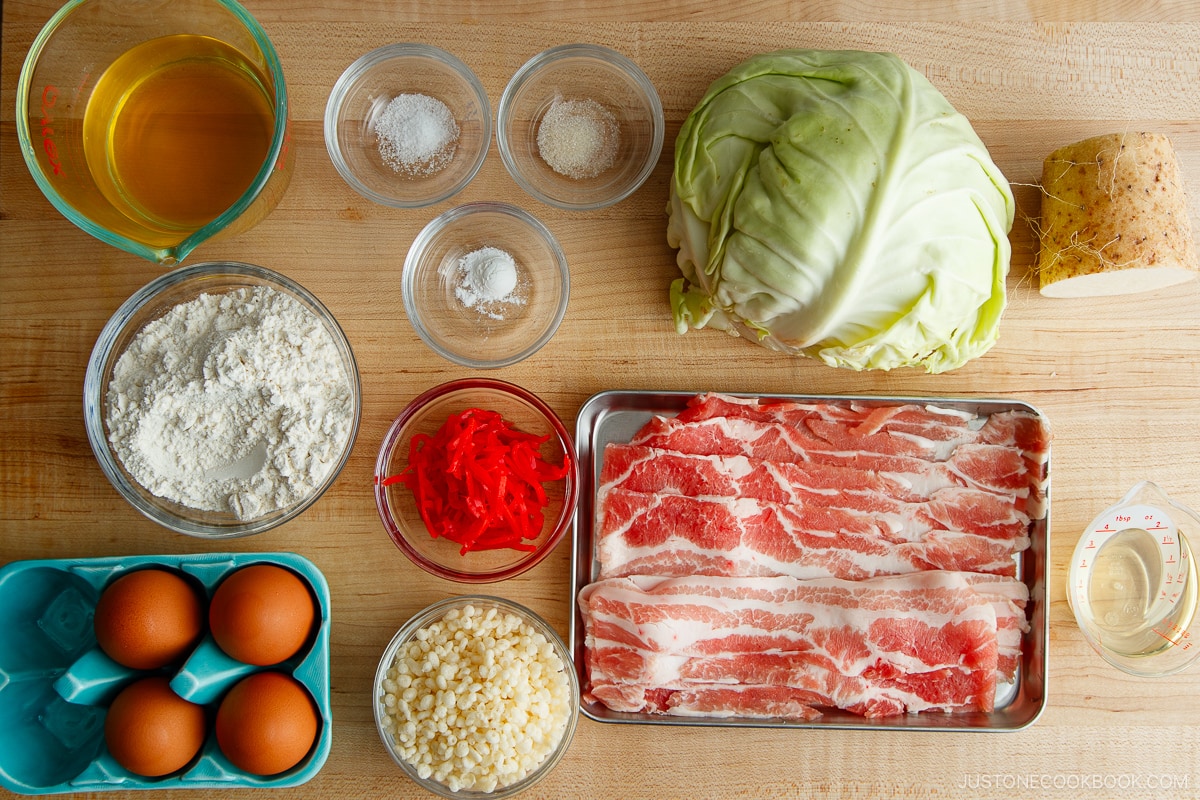
To Prepare the Base Batter
- In a large bowl, combine 1 cup all-purpose flour (plain flour), ¼ tsp Diamond Crystal kosher salt, ¼ tsp sugar, and ¼ tsp baking powder. Mix all together.
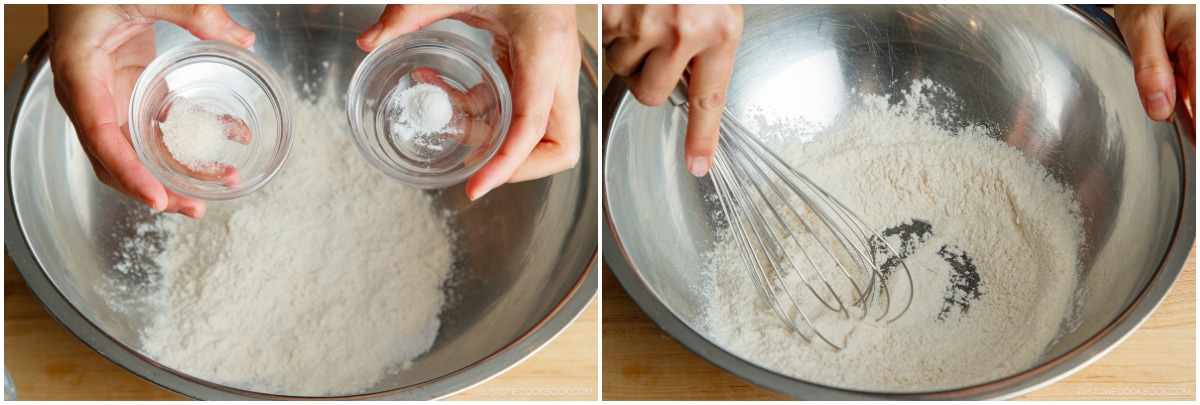
- Peel and grate 5.6 oz nagaimo/yamaimo (mountain yam) in a small bowl (I use a ceramic grater that I love). Note: The nagaimo may irritate your skin and cause itchiness. Work quickly and rinse your hands immediately after touching the nagaimo. It is very slimy and slippery, so make sure you have a good grip on the nagaimo if you wear kitchen gloves.
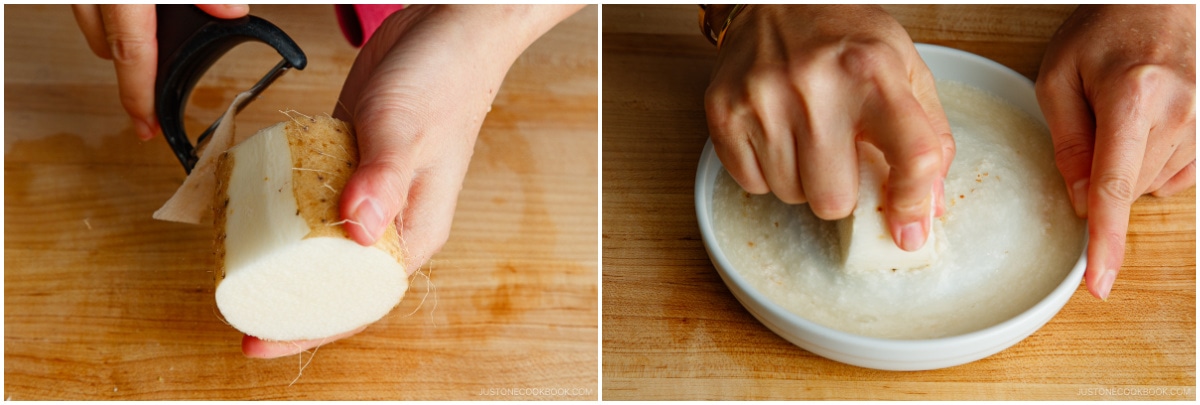
- Add the grated nagaimo and ¾ cup dashi (Japanese soup stock) to the bowl.
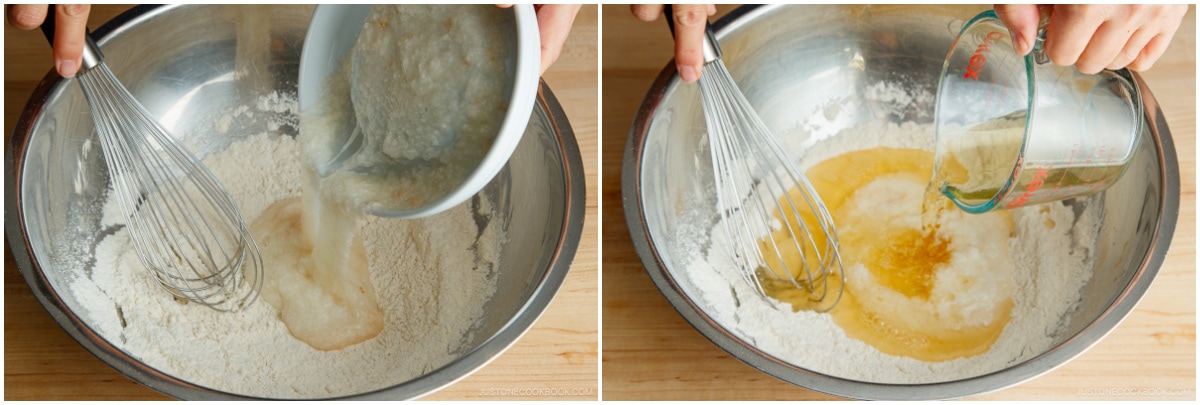
- Mix it all together until combined and set aside while you prepare the ingredients. If time allows, cover the bowl with plastic wrap, put it in the refrigerator, and let the batter rest for at least one hour (and up to overnight). Tip: Resting the batter relaxes the gluten, improves the flavor, and makes the okonomiyaki fluffier. Some okonomiyaki shops refrigerate the batter overnight.
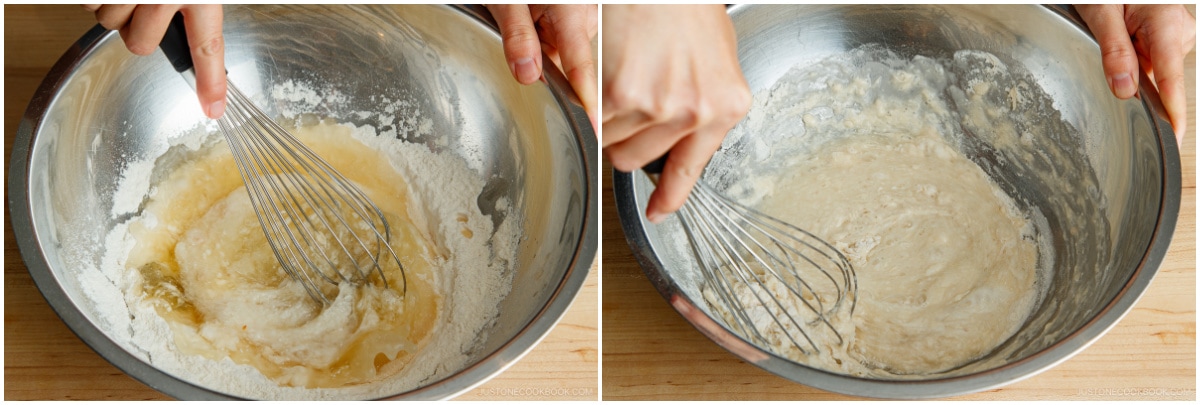
To Prepare the Ingredients
- Discard the core of ½ head green cabbage and cut into ½-inch (1.3-cm) slices.
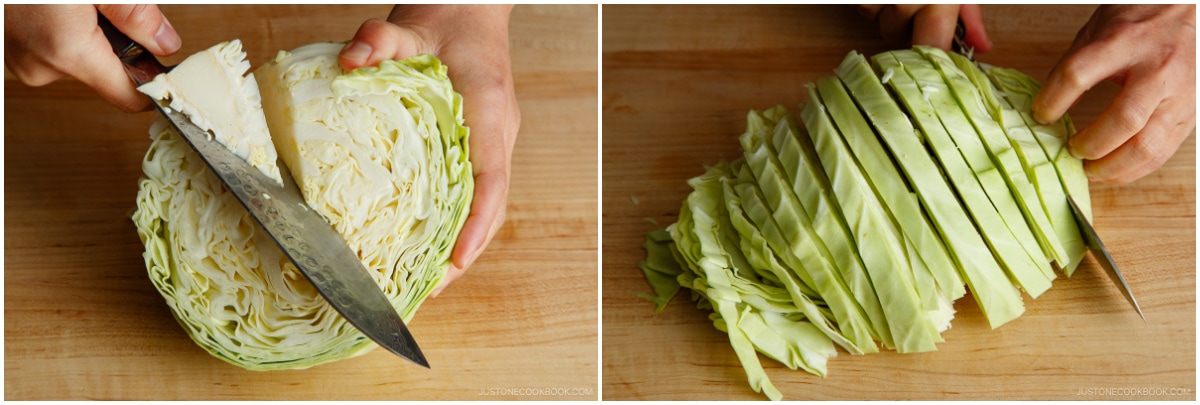
- Then, mince the cabbage strips. Wash the cabbage and drain well (I use a salad spinner) to remove excess moisture that could potentially dilute the batter.
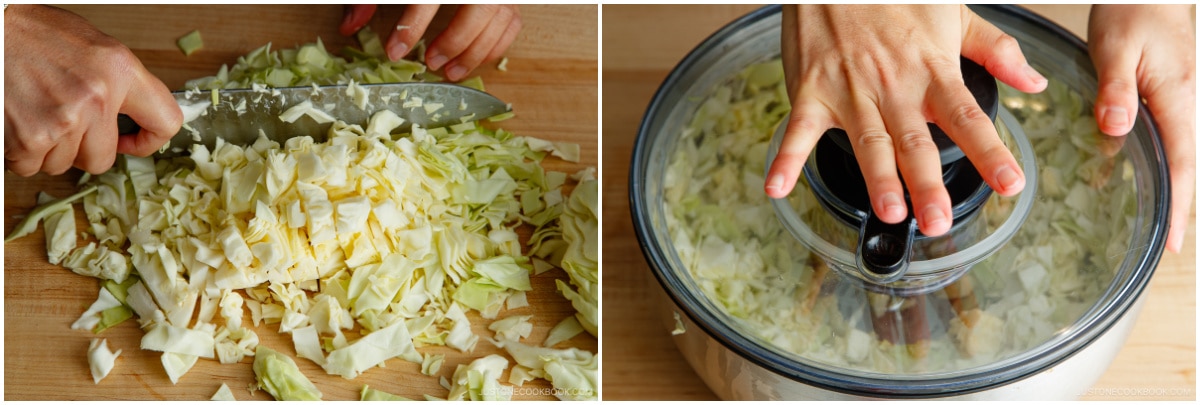
- Chop ¼ cup pickled red ginger (beni shoga or kizami beni shoga). Cut ½ lb sliced pork belly into 4-inch (10-cm) pieces and set aside.
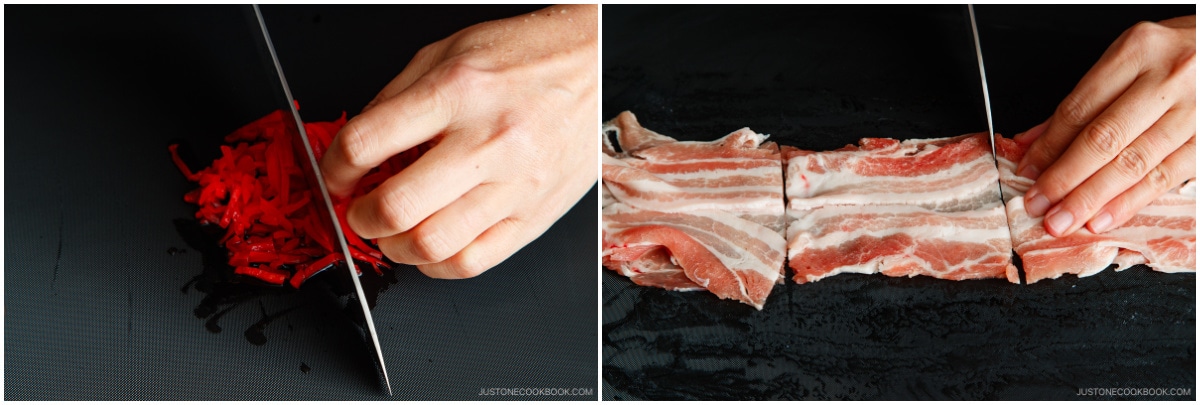
To Prepare the Okonomiyaki Batter
- If you rested the base batter for an hour or longer, take it out from the refrigerator. Add 4 large eggs (50 g each w/o shell), ½ cup tenkasu/agedama (tempura scraps), and two-thirds of the pickled red ginger to the bowl. Mix until combined.
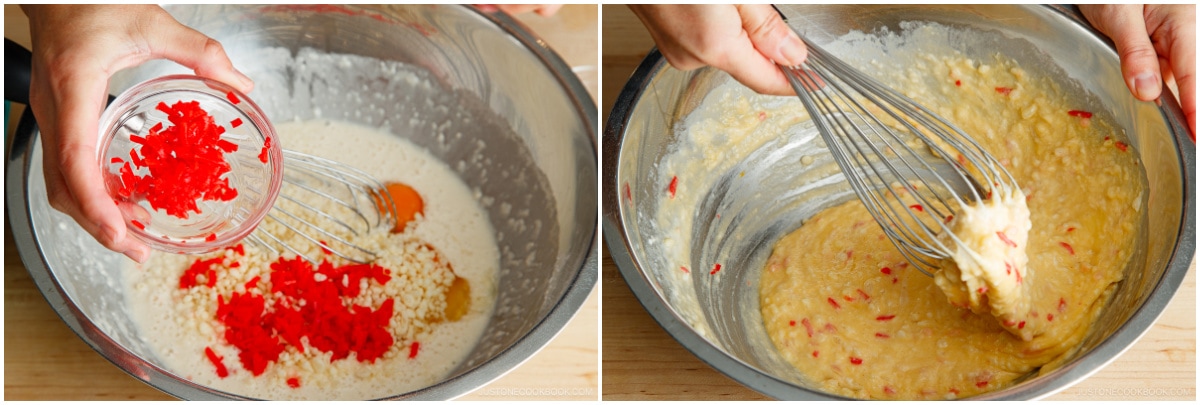
- Add the minced cabbage to the batter, one-third of it at a time. Mix well before each addition.
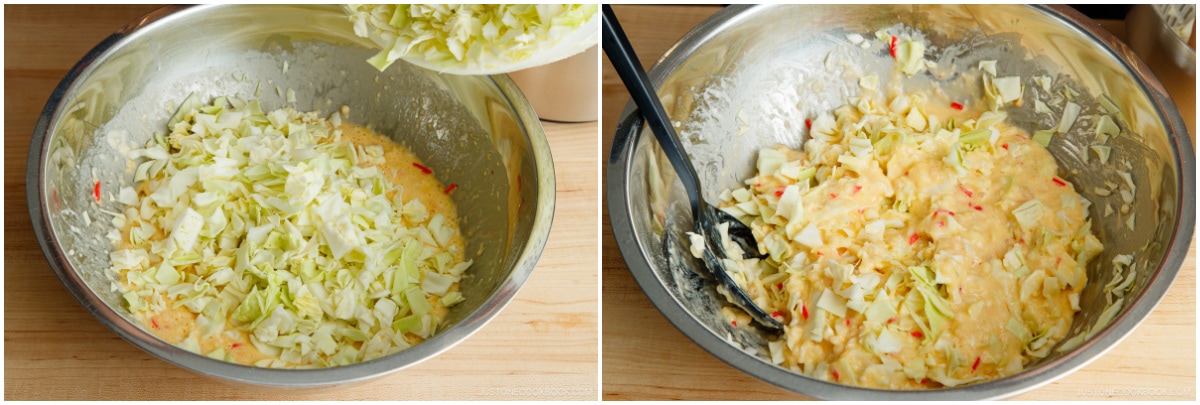
- Check the consistency of the okonomiyaki batter. Make sure the cabbage is coated well in the batter. You do not need to use all the minced cabbage if it is overpowering the batter.
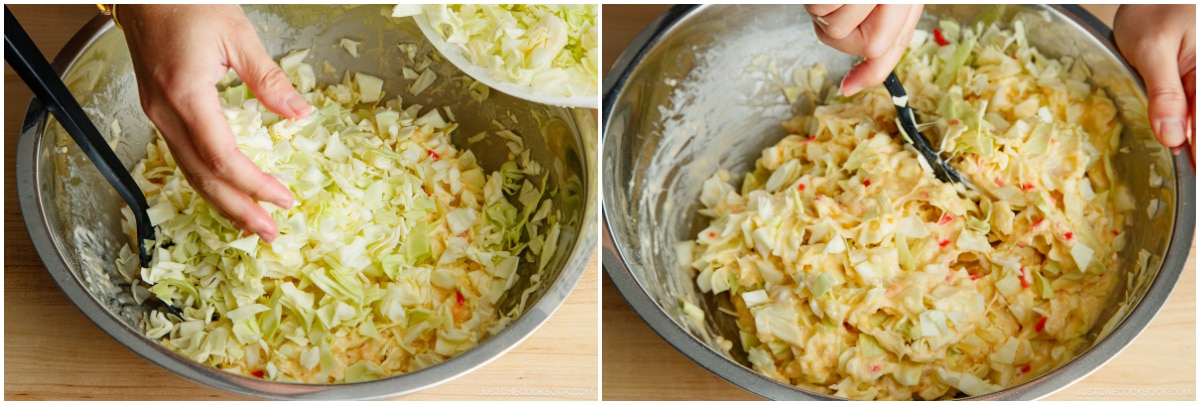
To Cook the Okonomiyaki
- Prepare a large griddle or two large frying pans with lids to cook two savory pancakes at a time. In the pans, heat a bit of neutral oil on medium heat. When it‘s hot (400ºF or 200ºC), add one portion of the batter to each pan.
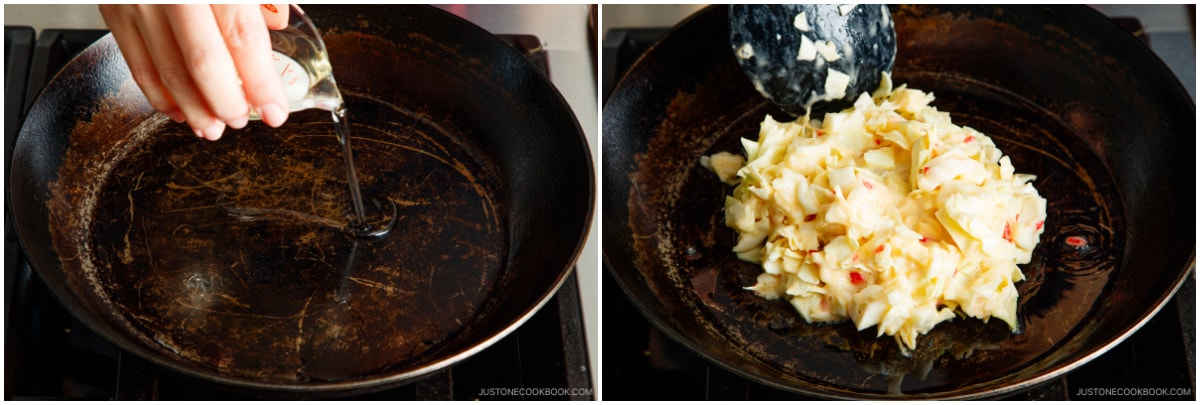
- Using spatulas, spread and shape the batter in a circle about 6 inches (15 cm) in diameter. We like thicker okonomiyaki (the final thickness is ¾ inches or 2 cm). If you’re new to making okonomiyaki, make it smaller and thinner so it’s easier to flip.
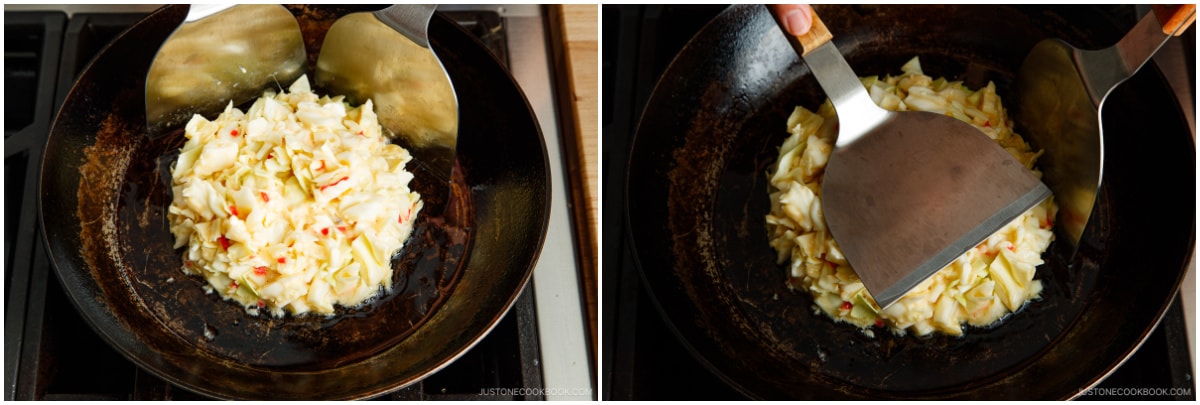
- Place 3 slices of pork belly on top of each okonomiyaki and cook, covered, on medium-low heat for 5 minutes.
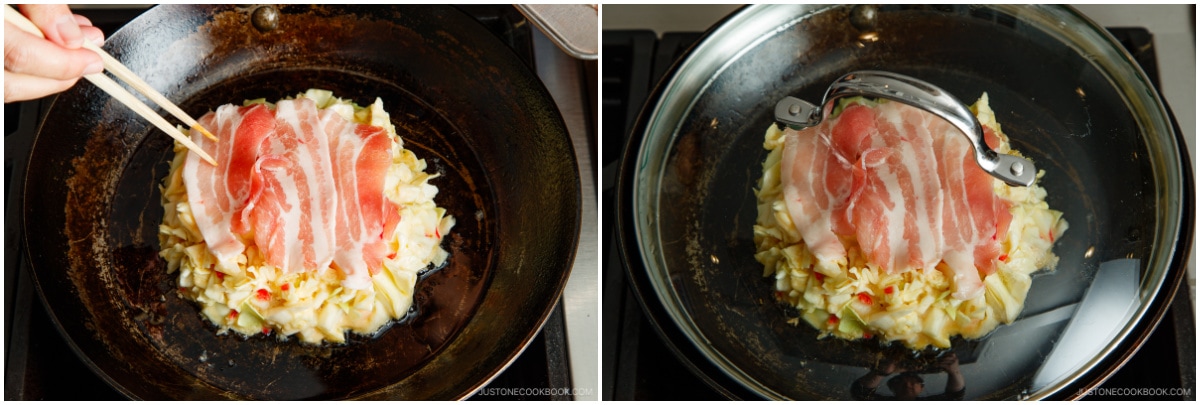
- When the bottom side is nicely browned, flip them over.
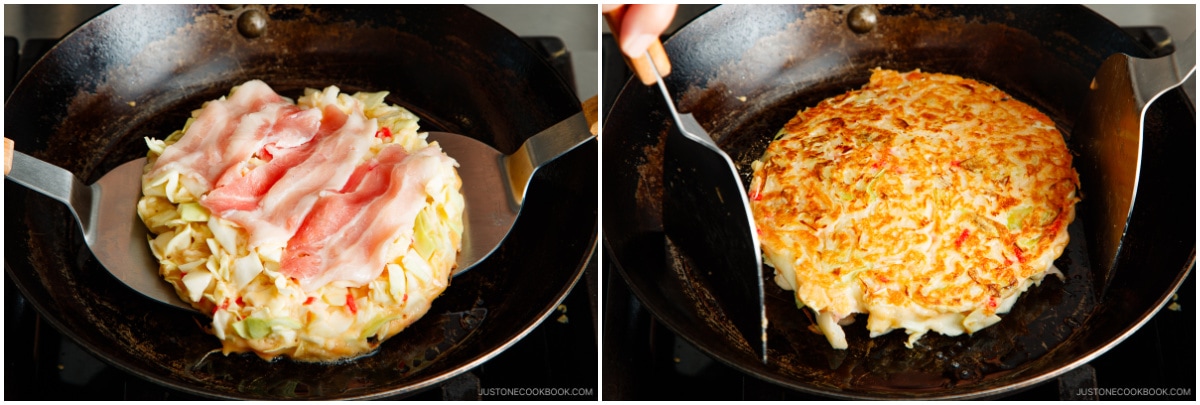
- Gently press the okonomiyaki to fix their shape and keep them together. Cook, covered, for another 5 minutes.
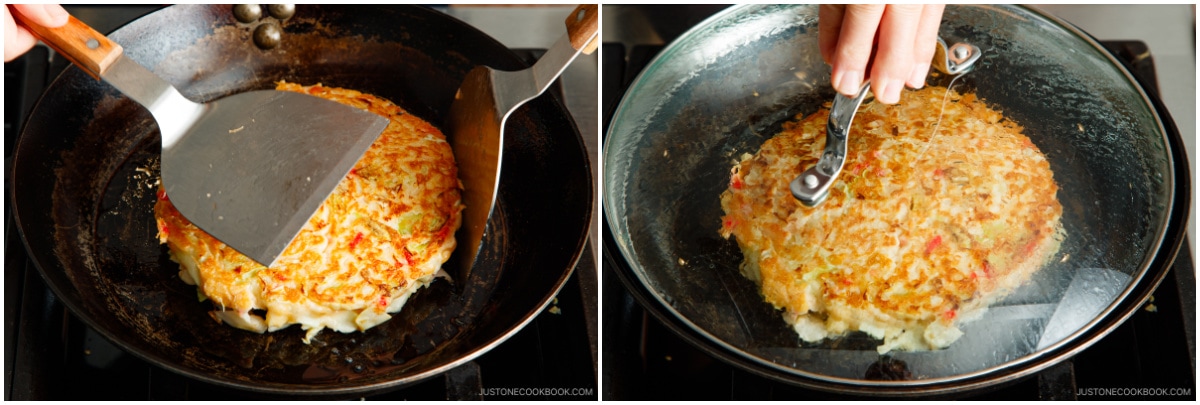
- Flip them over one last time and fix their shape. Then cook, uncovered, for 2 minutes.
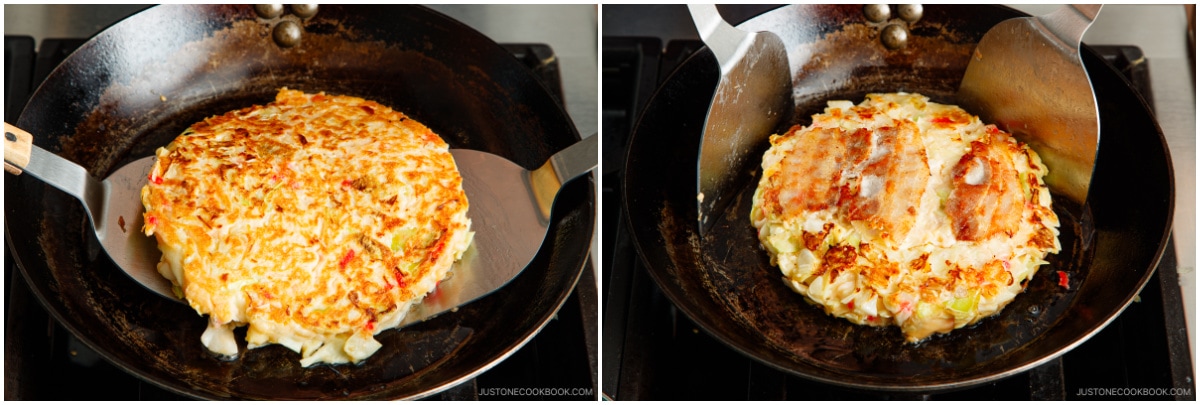
- Transfer the cooked okonomiyaki to individual plates. Continue cooking the rest of the okonomiyaki.
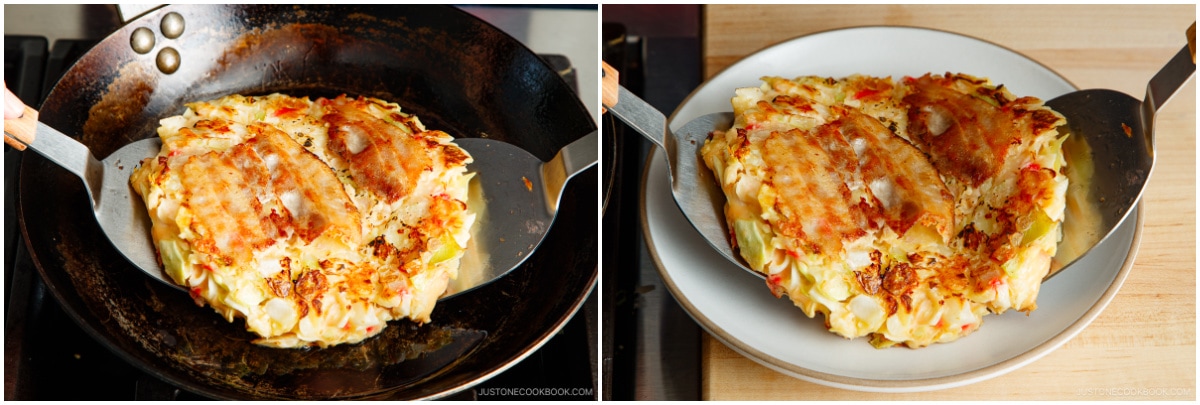
To Make the Quick Okonomiyaki Sauce (optional)
- Combine 3 Tbsp sugar, ¼ cup (4 Tbsp) oyster sauce, ½ cup (8 Tbsp) ketchup, and 7 Tbsp Worcestershire sauce in a small bowl. Mix all together until the sugar is completely dissolved.
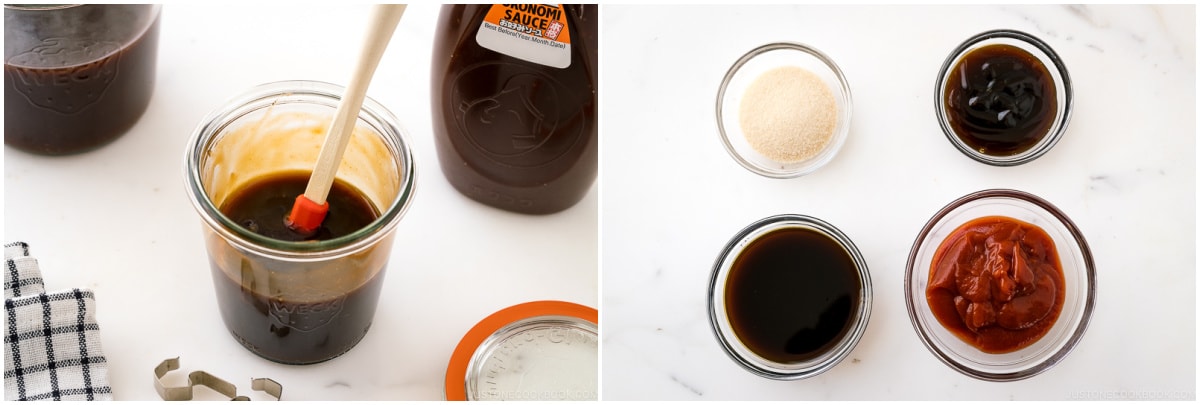
To Serve
- Now, it‘s time to customize your okonomiyaki with the condiments and toppings of your choice. In Japan, we spread okonomiyaki sauce on top with a brush or spoon.
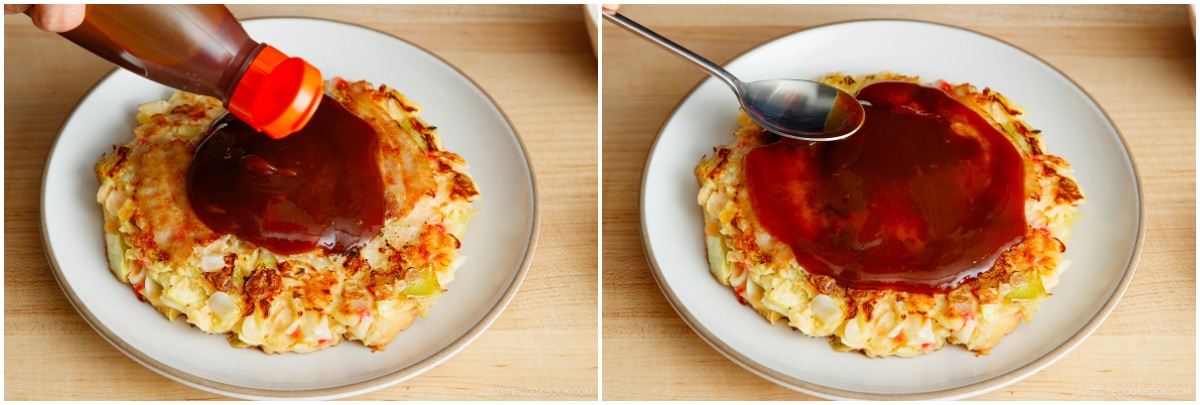
- Then, drizzle Japanese Kewpie mayonnaise (you can make my homemade recipe) in a zigzag pattern. Drag a chopstick tip through the mayo every ½ inch (1.3 cm) to create the iconic look.
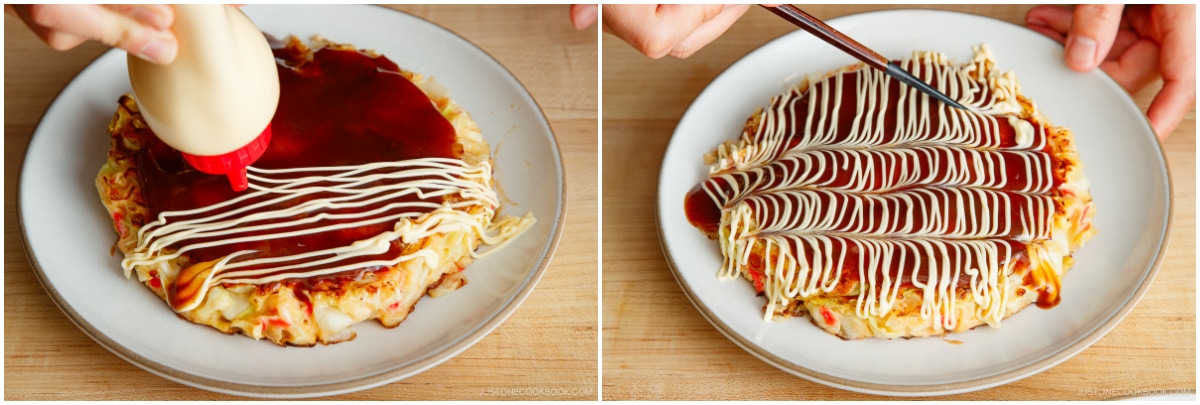
- We like to sprinkle the top with katsuobushi (dried bonito flakes), aonori (dried green laver seaweed), and chopped green onions/scallions. Finally, garnish with the remaining pickled red ginger (you can make my homemade beni shoga recipe).
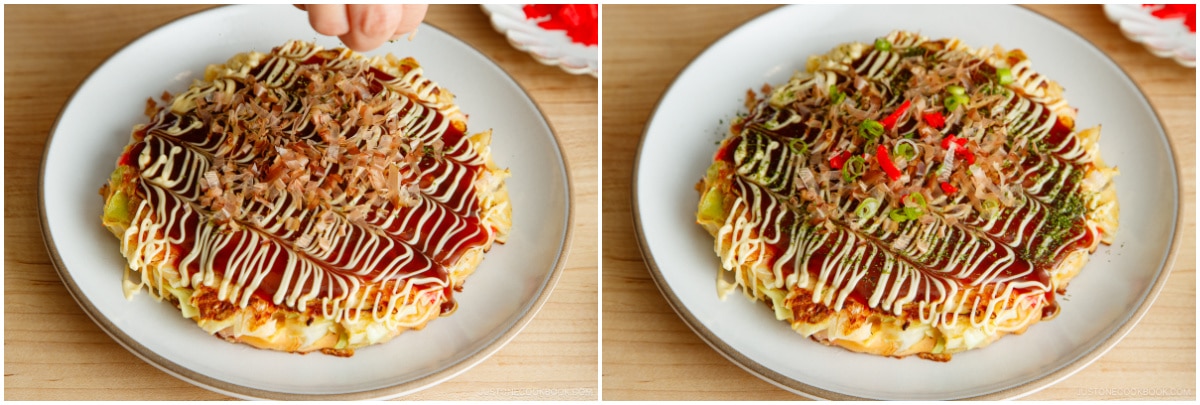
To Store
- Wrap each okonomiyaki (without the sauce or toppings) in aluminum foil and put it in a freezer bag. Store in the refrigerator for up to 3 days and in the freezer for a month.
To Reheat
- For the okonomiyaki from the refrigerator, reheat it in a toaster oven or oven at 350°F (180°C) for 10–15 minutes. For the okonomiyaki from the freezer, you can defrost it overnight in the refrigerator or reheat the frozen okonomiyaki in the oven for 25–30 minutes. It‘s a great quick meal!
To Cook Several Okonomiyaki at Once
- If you have a Japanese griddle with a lid (we call it a hot plate), you can cook several pieces of okonomiyaki at once. Otherwise, I recommend cooking one okonomiyaki at a time in a frying pan.
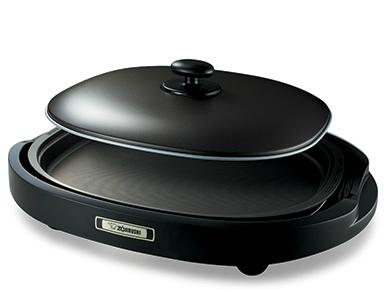
Nutrition
Editor’s Note: The post was originally published on Mar 2, 2011. It was republished with a new video, more helpful content, and new images on March 1, 2024.
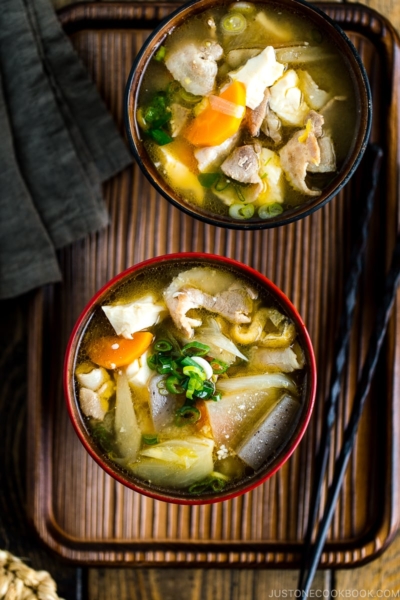
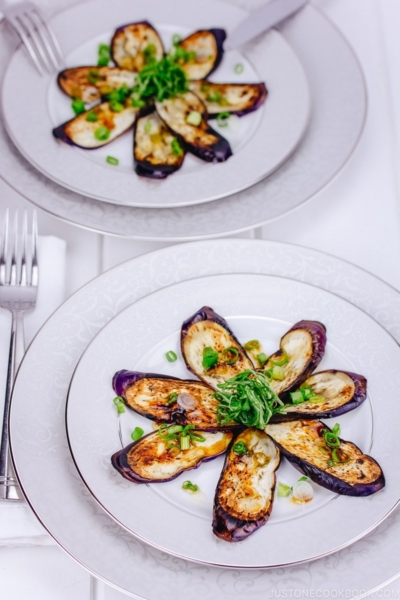
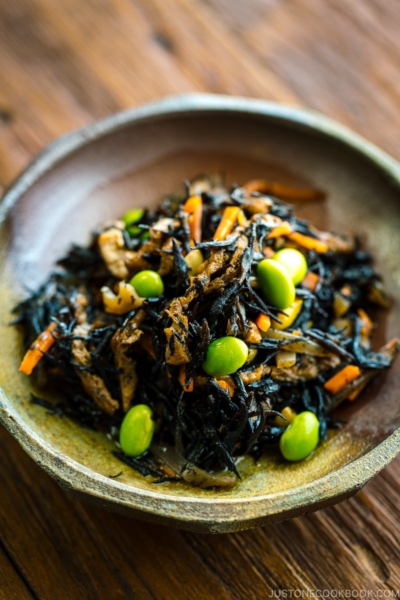
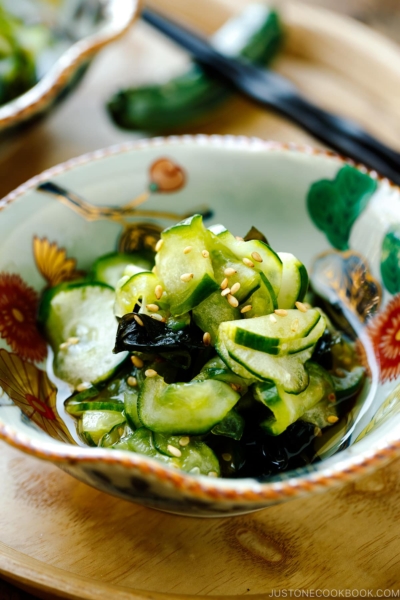




Hi. The recipe says “weigh your flour” but doesn’t say what the ideal weight should be. Why should it weigh? Thanks!
Hi DRS! You have to click the “metric” button to see the weight in gram. 🙂
Hi! If I’m using shrimp, should I place it on raw like you did with the pork? Or cook first?
Hello, Carmen. Thank you very much for trying Nami’s recipe!
Yes! You can add raw shrimp on top or mix them into the batter.
We hope you’ll like Ebi-Okonomiyaki!
This is amazing
Hi Butter! Thank you! 🤗
We are glad to hear you enjoyed Nami’s recipe.
Happy Cooking!
Great recipe. Comparable to a great okonomiyaki restaurant in Japan. I recently made these. 1 pork and 1 shrimp.
Hi Richard! Wow! Your Okonomiyaki looks so delicious!
Thank you for trying Nami’s recipe and for your kind feedback.
Happy Cooking!
Hi Nami,
We’ve made this recipe many times for our now legendary okonomiyaki dinner parties. I’ve invited a friend who is a vegan. Any advice on how to adapt the recipe, and replace the eggs?
Hi Evelien! Okonomiyaki dinner parties!🤩 It sounds fantastic!
You may use vegan dashi, shiitake mushrooms for pork, and 1/4 silken tofu for one egg.
We hope this helps!
Hi Naomi,
Thank you for your response, I will give it a go and report back for other curious people.
Best,
Evelien
Awesome!😊 Thank you, Evelien!
I’m vegan and make this recipe all the time! I use either veggie stock or a vegan shiitake/kombu stock (whatever I have on hand) and then use Just Egg for the eggs. 3 tablespoons of Just Egg is equivalent to 1 egg.
Hi Nami, Thank you for this delicious Okonomiyaki recipe and all the tips. We had trouble finding some of the key ingredients but I wanted to report some successful substitutes. Instead of nagaimo, we could only find “purple nagaimo” which has a brown bark-like exterior and white flesh with hints of purple skin. When grated, it was not slimy at all but it was fluffy and starchy (kind of like okara) and definitely helped create fluffier okonomiyaki. I added a little extra water to the batter to compensate for its lack of hydration. We also couldn’t find the Tenkasu that I swore was in my pantry so I experimented with Rice Krispies Cereal and it must have worked well enough because our final product was light and not doughy. We also used low-sodium bacon because it was easier to find than thinly sliced pork belly. It was a big hit. Thank you so much for all the hard work and time you put into creating accessible and delicious Japanese recipes!
Hello, Yoko! Wow! You are incredible! Thank you so much for taking the time to share your cooking experience with us!
Nami and the rest of us at JOC are thrilled that your Okonomiyaki came out so nicely.😊
Happy cooking!
SO DELICIOUS!! Just like the ones I used to eat in Japan when I was a child. Thank you for this wonderful recipe, I’ve made it twice now it’s that good. Excited to try the yakisoba recipe next with the leftover cabbage
Hi Michelle! Thank you so much for your kind feedback!
Nami and all of us at JOC are so happy to hear the flavor of Okonomiyaki was similar to what you remembered.☺️
Yes! We hope you enjoy Nami’s Yakisoba recipe as much as we do.
Happy Cooking!
Hi,
That was so yummy! I am Korean-American and my husband is Chinese-American and we live in SF / Torrance (Los Angeles) and both of us love Japanese food. We used to live in Japan for a few years but since neither of us are Japanese, have no idea how to cook the food. Thanks to your simple and very well-explained recipes, we can now enjoy them at home! This Okonomiyaki was such a hit with my vege-hating children (wow!) and I am so grateful to you for helping them eat their vegetables. Thank you so much! Will try it with calamari this time!
Hi Joanne! Thank you so much for trying Nami’s recipe and for your kind feedback!
We’re glad to hear Nami’s instructions were simple and easy to follow, and that you can now enjoy Japanese food at home!
We hope you continue to enjoy cooking with us. Happy cooking!
Hi Nami, Thank you for your recipe. It was perfect! My husband is from Japan, and when it comes to Okonomiyaki he is usually the chef. Today, I decided to surprise him and made okonomiyaki using your recipe. It came out just like the one we’ve eaten at Osaka and the whole family was pleased. Thanks for posting authentic, delicious Japanese food!
Hi Naira! Aww.🥰 Nami and all of us at JOC are so happy to hear you and your husband enjoyed the homemade Okonomiyaki.
Thank you so much for reading Nami’s post and trying her recipe! Happy Cooking! ❤️
Also, I am going to try substituting fresh leeks for some of the cabbage next time. I’ll let you know how that goes!
Hi Eduardo, Thank you for experimenting with Nami’s recipe!
There is a dish called Negi Yaki in Japan, and it’s very similar to what you are trying to make. It contains a lot of green onion.
So it should be very good. Enjoy!😊
Dear Nami and crew,
I absolutely had to post a comment to thank you for the wonderful and detailed recipe for okonomiyaki! Between the text and video I was able to create a perfectly delicious, and frankly darn pretty dish.
I first learned of okonomiyaki by watching Ranma 1/2 with the family. I also spent some time in Japan where I ate tons of amazing dishes but never had an okonomiyaki. My daughter is currently in her 2nd year learning Japanese, and hopes to go there for college (for a year, or a semester at least).
I found just about everything I needed at our local Asian market, except for tempura scraps, aonori, and the sauce. Thank goodness for your sauce recipe!
Okonomiyaki is the umami bomb! Thank you again!
Eduardo!
Hi Eduardo! Aww.🥰 Nami and all of us are glad to hear you enjoyed everything we shared! Thank you so much for trying Nami’s recipe and providing such a great review.
We hope your little one continues to enjoy learning Japanese as well.
Happy Cooking!
Loved this! Woke feeling a bit hmmmmm, what’s for lunch? And wanting to empty the crisper of that head of cabbage I bought last week! This was the perfect meal — and reminded us of many trips to Osaka.
Hi Cyn! We are so happy to hear you were able to recreate Osaka’s famous cuisine once again back home!
Thank you for trying Nami’s recipe and for your kind feedback.
Happy Cooking!
What 3 side dishes would you recommend preparing with?
Hi Tony! Thank you for trying Nami’s recipes!
We recommend a few vegetable dishes, soup, and rice.
What about these?
https://www.justonecookbook.com/homemade-miso-soup/
https://www.justonecookbook.com/chrysanthemum-greens-salad/
https://www.justonecookbook.com/sunomono-with-cucumber-and-wakame/
https://www.justonecookbook.com/onigiri-rice-balls/
We hope this helps!🙂
Omg Thank you soooo much for sharing!!! I wish we had a real authentic Japanese restaurant here in America 🙌🏼🙌🏼🥰🥰♥️♥️♥️
Hi Mitchy! Thank you for reading Nami’s post and trying her recipe!
Happy Cooking!
If we put mochi inside, is it kiri mochi that we use?
Hi Julia! Thank you for reading Nami’s post and trying her recipe!
Sure, you can use Kiri-mochi. You can also add homemade mochi.
We hope you enjoy it!